pewag textile lashing straps and textile lifting slings

/ Lashing2010and lifting E
2009

pewag textile straps and round slings, professional solutions for securing and elevating loads
With our polyester straps, you can deal with the high demands of load securing and hoisting technology in an economical and efficient way.
The pewag textile program comprises of a series of tested products which make the securing of your cargo easier. Our extra service: competent advice and training for dealers and users provided directly by the manufacturer.
3
pewag textile lashing straps and textile lifting slings Content
pewag group Welcome to the pewag group 4-5 History, Quality management 6 Business areas, Environment 7 Customer proximity 8 pewag textile lifting slings Information about pewag lifting means, round slings and webbing slings 12 Round slings 13-14 Webbing slings 15-20 Accessories 21 Webbing sling and round sling assemblies 22-23 Special articles from the pewag tex range 24-26 peTAG solution Keyfacts 27 Selecting the right textile lifting equipment 55 pewag tex lashing straps Information about pewag textile lashing straps 30 Information about load securing 30 Lashing straps 32-49 Lashing winch 50 Accessories 51-52 Anti-slide pad 53 Nets 54 Selecting the right textile lashing equipment 55 User manual User information for pewag textile lashing straps 58-59 Explanation of pewag tables 59-61 pewag Laser-protractor 61 Dynamic friction factors 61-62 User information for pewag textile webbing slings and round slings 62-63 Technical changes are subject to alterations. Misprints reserved.
Welcome to the pewag group
We are an internationally operating group of companies. Our track record goes back to the year 1479.
Mission Statement
pewag group‘s Mission Statement expresses the goals of our actions as follows: With our joy for innovation, we strive to make all products of the pewag group the best in the respective markets. The high quality of our products and services as well as our employees‘ passionate dedication are the foundation to our pursuit of outstanding services and complete customer satisfaction.
Principles of pewag group
Leading in Quality
The values of our product brands are demonstrated by our first-class quality and innovations and are communicated consistently and coherently.
We anticipate market demands and changes in the environment and adapt our strategies, organizations and actions accordingly to satisfy our customers’ needs through providing an optimal price-performance ratio: timely delivery, efficient and obliging service.
Leading in Responsibility
We commit ourselves to careful treatment of the environment, by reducing the use of energy and raw materials, ensuring the longevity of our products and making them recyclable.
We value an open, honest and team-oriented work-style, which is based on transparent communication honoring ideas, opinions and experience of our employees as valuable inputs for our decision making process. We strive for stable and fair partnerships with our employees, customers, suppliers and other business partners and take social aspects into consideration when making business decisions.
Leading in Technology
We secure our technological strength by striving for product quality, constant improvements and innovations of products, as well as manufacturing processes.
We strive to be the best in product technology. This ensures that our customers always have optimal solutions available and that we expand and protect our market position.
Leading in Economics
In all our processes we use due diligent business practices and efficiency and strive to improve these continuously.
In the long-term, we will continuously increase our economic performance to raise corporate value, achieve sustained growth and thus secure a successful future of the organization.
4 pewag group pewag textile lashing straps and textile lifting slings
We are a modern group of companies which looks back to a tradition and experience of more than 500 years. Since our founding years, a lot has changed, but the values that made our success possible from the beginning remain.
pewag group –Innovation. Quality. Partnership.

pewag group
History of the pewag group
Advantage through tradition

The history of pewag group goes back to the 15th century and therefore makes us one of the oldest chain manufacturer worldwide. With our experience we are ready for the future.
Timetable of important events
1479 First documented references of a forging plant in Brückl

1787 Foundation of a chain forge in Kapfenberg
1803 Foundation of a chain forge in Graz
1836 Establishment of an iron casting plant in Brückl

1912 Production of the first pewag snow chain

1923 Merger of plants in Graz and Kapfenberg –Creation of the name “pewag”
1972 Foundation of a sales company in Germany
1975 Foundation of a sales company in the USA

1993 Foundation of pewag austria GmbH
1994 Foundation of the first subsidiary in Czech Republic
1999 Acquisition of the Weissenfels Group
2003 Separation from the Weissenfels Group
2005 Reorganization into 2 groups: Schneeketten Beteiligungs AG Group – Snow Chains pewag austria GmbH Group – Technical Chains



2009 Acquisition of Chaineries Limousines S.A.S.
2012 Foundation of the first manufacturing company in the USA
2013/ Foundation of various international sales
2014 companies
Quality management
Our main goal is customer satisfaction.
In this instance, quality means that only those products and services are developed, manufactured and delivered which completely and without compromise satisfy the customer.
The pewag group’s quality policy, is underlined by the following basic principle: “we supply high-end products and services to our customers that conform to the technical standards and requirements”, can be summarised in the subsequent four points.
Market-oriented Quality
In order to maintain and to widen the competitive position of the pewag group, the quality of finished goods and services must be consistent with the specifications of the customer and also with their expectations of one of the leading companies. No product should ever pose a danger to people or the environment.
Economic Quality
As a profit-oriented company, quality is achieved by taking into consideration the material, personnel and financial resources; this means that we establish an appropriate best price/performance ratio for the customer within the acknowledged framework.
Quality Responsibility
Stringent demands are placed on all employees to ensure high standards of quality. No matter what hierarchical level, all managers are in charge of managing quality. Every employee within the pewag group should be educated, motivated and instructed by the management team. It is important for promoting high quality awareness that the education and training of employees is at the forefront, as each employee is responsible for the quality of his/her own work.
For each of our employees, the statement “QUALITY STARTS WITH ME” must be true!
Process-oriented Quality
The close interaction between sales, product development, production and customer service is regulated within the individual companies by fixed processes and activities, as well as responsibilities with the aim to reach and maintain the defined quality standards.
6 pewag group pewag
textile lashing straps and textile lifting slings
Lithography forging plant Brückl 1855
Anchor chain forge 1878 Chain forgers 1956
areas
Working with pewag products
The pewag group has a substantial and diverse spectrum of products and services.



Our range of products varies from traction chains for tires (snow chains for passenger cars, trucks and special-purpose vehicles, tire protection chains for mining vehicles) over different industrial chains to products for the do-it-yourself sector (light chains, belts, etc.)
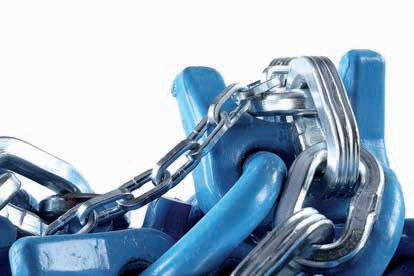
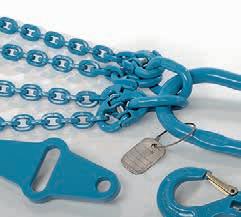

Environment
we take responsibility
Ecological awareness in all areas
Our company’s manufacturing location in Kapfenberg, Austria, has been used for iron and steel production for over 270 years. A second facility located in Brückl, Austria, was first documented in records dating back to 1479. Based on this long manufacturing tradition, we take serious responsibility for our products, employees and the environment at all our international locations. Hence, one of our major concerns is to improve energy efficiency and, in doing so, to minimise energy consumption over a long period of time with the development of new production technologies. An important goal is to increase energy efficiency and consequently lower energy demand. Consequently, we develop our products to achieve longer product life-cycles and lower weight but simultaneously, increasing their working load capacities and the safety for our customers. We are committed to upholding all relevant energy and environmental standards by setting clearly defined goals and continually improving our performance. To achieve this goal, we use modern manufacturing technologies. An important step is to provide the necessary resources and to include our employees in the process. We are convinced that well-informed and motivated employees can actively participate in environmental conservation.
Wherever we are unable to avoid an environmental impact, we have set ourselves the goal to continually reduce our energy consumption, waste and environmentally harmful emissions. When purchasing new equipment, we strive to find the best and most efficient technical solution possible. It is important for us to promote the purchase of energy efficient products and services.
Our process-oriented management system regulates the documentation concerning all environmental relevant procedures. It also encompasses preventative measures for possible failures, as well as behavioural instructions for regular and/or extraordinary operational procedures. By systematically monitoring and assessing our environmental activities, we are quickly able to resolve deviances and to take corrective action. This process extends throughout the whole organisation to optimise all business processes. We strive to engage in an open dialogue with our customers, neighbours and authorities to inform them of our energy and environmental engagements.
Through specific communication we want to inform our customers about the environmental aspects of our products – specifically inform them about the longevity of our products. Through meaningful communication, we strive to motivate our suppliers and customers to think – in turn – about their environmental footprint and to put into practice similar environmental standards in their businesses.
7 pewag group
pewag textile lashing straps and textile lifting slings Business
–
Segment A
Snow and forestry chains
Segment B Hoist and conveyor chains
Segment D Engineering
Segment C
Do-it-yourself
Segment F
Lifting and lashing chains and accessories
Segment G Tire protection chains
Customer proximity
International presence
In the ambitious five-hundred year history pewag has evolved from a small and modest company to a global organization with several subgroups.
With 12 production and 39 sales and other locations on all five continents, pewag documented its claim as one of the world’s leading chain manufacturers.
In addition to the numerous locations pewag as an international company relies on his capillary, strong, and professional partner network. These collaborations provide optimal customer service in currently more than 100 countries around the world.
Production and sales locations
Europe
Austria pewag austria GmbH, Graz
pewag austria GmbH, Kapfenberg
pewag Schneeketten GmbH & Co KG, Graz
pewag Schneeketten GmbH & Co KG, Brückl
pewag engineering GmbH, Kapfenberg
pewag austria Vertriebsgesellschaft mbH, Graz
pewag Ketten GmbH, Klagenfurt
pewag International GmbH, Klagenfurt
Germany pewag Deutschland GmbH, Unna
pewag Schneeketten Deutschland GmbH, Unna
France pewag france SAS, Echirolles / Grenoble Chaineries Limousines SAS, Bellac
Italy pewag italia srl, Andrian
Croatia pewag d.o.o, Kroatien, Zagreb
The Netherlands pewag nederland BV, Hillegom
APEX International BV, Hillegom
APEX Automotive BV, Hillegom
Poland pewag polska Sp z.o.o., Buczkowice
Portugal pewag Portugal – Comercio de Produtos e Eqibamentos Industrials, Lda, Santo Antão do Tojal
Romania pewag Romania SRL, Sibiu County
Russia OOO “PEWAG", Moscow
Sweden pewag sweden AB, Emmaboda
Slovakia pewag Slovakia sro, Nitra
Czech Republic pewag Czech sro, Vamberk
pewag Snow Chains sro, Vamberk
pewag sro, Vamberk
pewag Czech sro, Česká Trebová
peform Chrudim sro, Chrudim
Europe
Ukraine TOV pewag Ukraine GmbH, Lviv
North America
USA pewag Inc, Bolingbrook, Illinois
pewag Inc, Rocklin, California
pewag Traction Chain Inc, Pueblo, Colorado
Mexico pewag Mexico SA de CV, Mexico
South America
Brazil pewag Brasil Comércio de Correntes Ltda., São Paulo
Colombia pewag Columbia S.A.S, Medellin
Africa
South Africa pewag chain south africa (pty) ltd., Rivonia
Australia
Australia pewag australia Pty Limited, Barrack Heights
Asia
India pewag India Private Limited, Bangalore
8 pewag group pewag textile
lashing straps and textile lifting slings
pewag group presents itself on the internet. More ... www.pewag-group.com www.pewag.com pewag
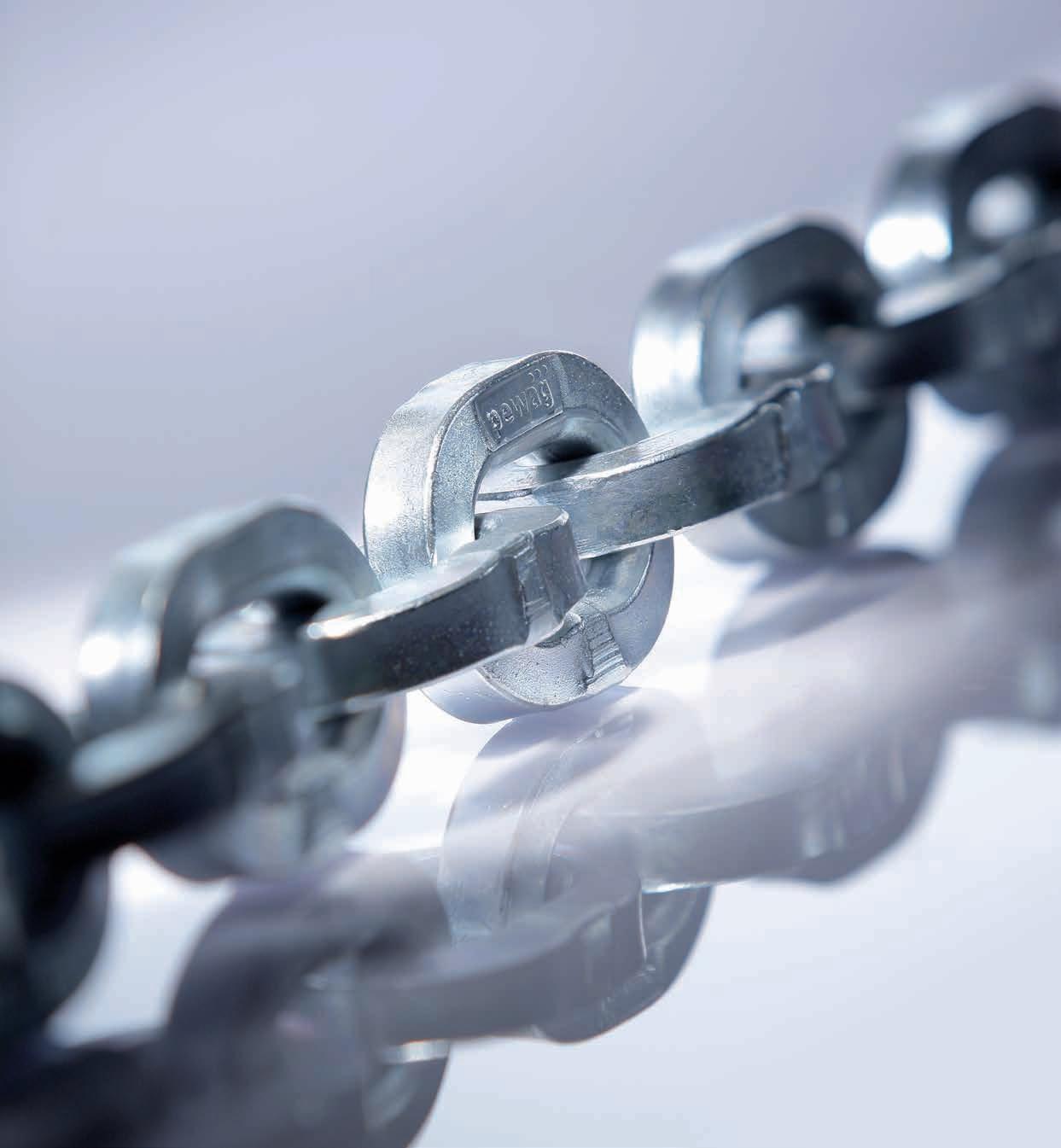
pewag group
–
Partnership.
group
Innovation. Quality.
pewag textile lifting slings
Product overview

10 Content Information about pewag lifting means, round slings and webbing slings 12 Round slings 13-14 Webbing slings 15-20 Accessories 21 Webbing sling and round sling assemblies 22-23 Special articles from the pewag tex range 24-26 peTAG solution Keyfacts 27 Selecting the right textile lifting equipment 55

11
pewag textile lifting slings


pewag textile lifting slings for overhead lifting of loads are produced in conformance with the European Standards EN 1492-1 and EN 1492-2, as well as with the Machinery Safety Regulations 2010 (MSV) and the Machinery Directive 2006/42/CE. pewag textile lifting slings are made from high tensile polyester (PES), recognizable by the blue label. PES is suitable to be used and stored with temperatures ranging from -40° to +100 °C and has no expiry date according to the law. Our wide range of round slings and webbing slings can be extended to suit special needs. Technical data and user information can be found on each sling; more detailed information is also provided by the user manual at the end of this catalog.
pewag textile round slings
pewag textile round slings are made from 100 % polyester (PES) and are ideal for heavyweight applications because of their lightness, flexibility and load friendliness. The test in accordance with the EN 1492-2 and Machinery Safety Regulations 2010 (MSV), the colour coding and working load limit lines ensure the user friendliness and safeness of our roundslings. The wide range of round slings goes up to working load limits of 300 tons. Consecutive numbered labels facilitate the documentation, e.g. for regular inspectations.
pewag textile webbing slings
pewag textile webbing slings are made from 100 % polyester (PES) and produced in 3 different designs. The test in accordance with the EN 1492-1 and Machinery Safety Regulations 2010 (MSV), the colour coding and working load limit strips ensure the user friendliness and safeness of our webbing slings. The wide range of webbing slings comprising webbing slings with reinforced eyes, endless webbing slings and webbing slings with metal end fittings can be complemented with special webbing sling types and accessories to meet customer’s requirements.
pewag textile lashing straps and textile lifting slings
pewag textile lifting slings
12
Lifting operation using round slings
Round slings RS
according to EN 1492-2 and the Machinery Safety Regulations (MSV)
Working load limit table (kg) according to the type of sling:
Available
Order example:
Polyester round sling type RS 1 with an effective working length (L1) of 3,000 mm (circumferential length = 6,000 mm), according to EN 1492-2, working load limit in endless slings 1,000 kg.


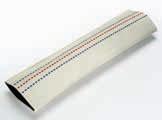

Order text:
Round sling RS 1 x 3,000

Accessories:
AS Protective sleeve GS Edge wear pad

pewag textile lifting slings
13
pewag textile lashing straps and textile lifting slings
Type Colour coding Endless sling 100 % Choke hitch 80 % 200 % 140 % 100 % Asymmetrie 100 % Stock length / effective working length [m] Weight per circumferential length approx. [kg/m] RS 1 purple 1,000 800 2,000 1,400 1,000 1,000 0.50 / 1 / 1.50 / 2 / 2.50 / 3 / 4 / 5 / 6 0.14 RS 2 green 2,000 1,600 4,000 2,800 2,000 2,000 0.50 / 1 / 1.50 / 2 / 2.50 / 3 / 4 / 5 / 6 0.23 RS 3 yellow 3,000 2,400 6,000 4,200 3,000 3,000 1 / 1.50 / 2 / 2.50 / 3 / 4 / 5 / 6 0.31 RS 4 grey 4,000 3,200 8,000 5,600 4,000 4,000 1 / 1.50 / 2 / 2.50 / 3 / 4 / 5 / 6 0.41 RS 6 brown 6,000 4,800 12,000 8,400 6,000 6,000 1 / 1.50 / 2 / 2.50 / 3 / 4 / 5 / 6 0.60 RS 8 blue 8,000 6,400 16,000 11,200 8,000 8,000 1 / 1.50 / 2 / 2.50 / 3 / 4 / 5 / 6 / 8 / 10 0.75 RS 10 orange 10,000 8,000 20,000 14,000 10,000 10,000 2 / 3 / 4 / 5 / 6 0.95 RS 12 orange 12,000 9,600 24,000 16,800 12,000 12,000 available in all effective working lengths up to 15 m 1.32 RS 15 orange 15,000 12,000 30,000 21,000 15,000 15,000 available in all effective working lengths up to 15 m 1.50 RS 20 orange 20,000 16,000 40,000 28,000 20,000 20,000 available in all effective working lengths up to 15 m 2.00 RS 25 orange 25,000 20,000 50,000 35,000 25,000 25,000 available in all effective working lengths up to 15 m 2.68
up to 300 tons
sleve
from Polyurethan Available with For more information, see p. 27
KSPU Edge protection profile
Edge protection angles made
Round slings RS PRO
acc. to EN 1492-2 and the Machinery Safety Regulations
• With robust protective sleeve
• Significantly longer lifespan thanks to optimised wear and abrasion resistance






• Load capacity is woven into the material
Working load limit table (kg) according to the type of sling:
Order example: Polyester round sling type RS PRO 1 with an effective working length (L1) of 3,000 mm (circumferential length = 6,000 mm), according to EN 1492-2, working load limit in endless slings 1,000 kg. Order text: Round sling RS PRO 1 x 3,000
14
pewag textile lashing straps and textile lifting slings pewag textile lifting slings
Type Colour coding Endless sling 100 % Choke hitch 80 % 200 % 140 % 100 % Asymmetrie 100 % Weight per circumferential length approx. [kg/m] RS PRO 1 purple 1,000 800 2,000 1,400 1,000 1,000 0.16 RS PRO 2 green 2,000 1,600 4,000 2,800 2,000 2,000 0.25 RS PRO 3 yellow 3,000 2,400 6,000 4,200 3,000 3,000 0.24 RS PRO 4 grey 4,000 3,200 8,000 5,600 4,000 4,000 0.45 RS PRO 6 brown 6,000 4,800 12,000 8,400 6,000 6,000 0.66 RS PRO 8 blue 8,000 6,400 16,000 11,200 8,000 8,000 0.88 RS PRO 10 orange 10,000 8,000 20,000 14,000 10,000 10,000 1.20 RS PRO 12 orange 12,000 9,600 24,000 16,800 12,000 12,000 1.40 RS PRO 15 orange 15,000 12,000 30,000 21,000 15,000 15,000 1.74
NEW Available with For more information, see p. 27 Accessories: AS Protective sleeve GS Edge wear pad KSPU Edge protection profile sleve Edge protection angles made from Polyurethan
Webbing sling type B2
acc. to the European standard EN 1492-1 and the Machinery Safety Regulations


• With reinforced eyes
Working load limit table (kg) according to the type of sling:

Order example:
Webbing sling according to EN1492-1 type B2, two-layer webbing slings with reinforced eyes, webbing width 90 mm, effective working length L1 = 2,000 mm, made from polyester PES, working load limit for straight and direct lifting 3,000 kg


Order text:
Webbing sling B2 90 x 2,000 / 3,000
15 pewag textile lifting slings
pewag textile lashing straps and textile lifting slings
Webbing width [mm] Colour coding 100 % 80 % 200 % 45° 140 % 60° 100 % 30 purple 1,000 800 2,000 1,400 1,000 60 green 2,000 1,600 4,000 2,800 2,000 90 yellow 3,000 2,400 6,000 4,200 3,000 120 grey 4,000 3,200 8,000 5,600 4,000 150 red 5,000 4,000 10,000 7,000 5,000 180 brown 6,000 4,800 12,000 8,400 6,000 240 blue 8,000 6,400 16,000 11,200 8,000
Available with For more information, see p. 27 Accessories: AS Protective sleeve GS Edge wear pad KSPU Edge
protection profile sleve Edge protection angles made from Polyurethan
Webbing sling type A2


endless webbing sling, according to EN 1492-1 and the Machinery Safety Regulations (MSV)


Working load limit table (kg) according to the type of sling:

Order example:
Endless webbing sling according to EN1492-1 type A2, one-layer webbing sling, width 150 mm, effective working length 3,000 (circumferential length L1 = 6,000 mm), made from polyester PES, working load limit in endless slings 5,000 kg.
Order text: Webbing sling A2 150 x 3,000 / 5,000
Accessories:
AS Protective sleeve GS Edge wear pad

16 pewag textile
pewag
lashing straps and textile lifting slings
textile lifting slings
Width [mm] Colour coding 100 % 80 % 200 % 45° 140 % 60° 100 % 30 purple 1,000 800 2,000 1,400 1,000 60 green 2,000 1,600 4,000 2,800 2,000 90 yellow 3,000 2,400 6,000 4,200 3,000 120 grey 4,000 3,200 8,000 5,600 4,000 150 red 5,000 4,000 10,000 7,000 5,000 180 brown 6,000 4,800 12,000 8,400 6,000 240 blue 8,000 6,400 16,000 11,200 8,000
Available with For more information, see p. 27
KSPU
Edge protection profile sleve
Edge protection angles made from Polyurethan
Webbing sling type Cr2


according to EN 1492-1 and the Machinery Safety Regulations (MSV)
• with high strength fittings

Working load limit table (kg) according to the type of sling:

Order example:
Webbing sling according to EN1492-1 type Cr2, two-layer webbing sling, width 90 mm, effective working length 4,000, made from polyester PES, WLL for straight and direct lifting 3,000 kg with high strength fittings EZD 100 on both sides.
Order text:
Webbing sling Cr2 90 x 4,000 / 3,000 EZD-EZD

17 pewag textile lifting slings
pewag textile lashing straps and textile lifting slings
Width [mm] Colour coding 100 % 80 % 200 % 45° 140 % 60° 100 % 30 purple 1,000 800 2,000 1,400 1,000 60 green 2,000 1,600 4,000 2,800 2,000 90 yellow 3,000 2,400 6,000 4,200 3,000 120 grey 4,000 3,200 8,000 5,600 4,000 150 red 5,000 4,000 10,000 7,000 5,000 180 brown 6,000 4,800 12,000 8,400 6,000 240 blue 8,000 6,400 16,000 11,200 8,000
Available with For more information, see p. 27
Accessories: AS Protective sleeve GS
Edge wear pad KSPU
Edge protection profile sleve
Edge protection angles made from Polyurethan
Webbing sling type B2 4-layer
• Webbing slings for use with heavy loads



• Double the load capacity of 2-layer webbing slings of the same width


Working load limit table (kg) according to the type of sling:
Order example:
Webbing sling according to EN1492-1 type B2, four-layer webbing slings with reinforced eyes, webbing width 30 mm, effective working length L1 = 4,000 mm, made from polyester PES, working load limit for straight and direct lifting 2,000 kg

Order text:
Webbing sling B2 4-layer 30 x 4,000 / 2,000

18 pewag textile
pewag
lashing straps and textile lifting slings
textile lifting slings
Width [mm] Colour coding 100 % 80 % 200 % 45° 140 % 60° 100 % 30 green 2,000 1,600 4,000 2,800 2,000 60 grey 4,000 3,200 8,000 5,600 4,000 90 brown 6,000 4,800 12,000 8,400 6,000 120 blue 8,000 6,400 16,000 11,200 8,000 150 orange 10,000 8,000 20,000 14,000 10,000 180 orange 12,000 9,600 24,000 16,800 12,000 240 orange 16,000 12,800 32,000 22,400 16,000 300 orange 20,000 16,000 40,000 28,000 20,000
Available with For more information, see p. 27 NEW
GS
Webbing sling 4-layer structure
Accessories: AS Protective sleeve
Edge wear pad
KSPU Edge protection profile sleve
Edge protection angles made from Polyurethan
Webbing slings with solid coating
• Solid coating is firmly moulded onto the webbing sling
• Transparent for improved texture control
Working load limit table (kg) according to the type of sling:
• Double-sided coating with a min. thickness of 5 mm
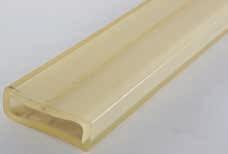
• Webbing slings with a solid coating may only be used when the load cannot move in the webbing sling, i.e. when no relative movements occur between the coating and the load
Edge protections profile sleeve
• Excellent protection against wear and tear for textile lifting accessories and lashing straps
• Good resistance even with sharp edges and rough load surfaces

• Standard version may be used on two sides; other special versions are available upon request
Available
with
19 pewag textile lifting slings
pewag textile lashing straps and textile lifting slings
Edge protection profile sleeve Type for lifting sling Fig. 1 + 2 for round sling Fig. 3 + 4 for round sling Fig. 5 + 6 KSPU 30 30 mm 1 t KSPU 50 2 t KSPU 60 60 mm 1 t KSPU 90 90 mm 3 t 4 t KSPU 120 120 mm 4 t 6 t KSPU 150 150 mm 12 t, 15 t KSPU 180 180 mm 8 t 20 t KSPU 240 240 mm KSPU 300 300 mm 20 t, 25 t
Width Colour coding 100 % 80 % 200 % 45° 140 % 60° 100 % 30 purple 1,000 800 2,000 1,400 1,000 60 green 2,000 1,600 4,000 2,800 2,000 90 yellow 3,000 2,400 6,000 4,200 3,000 120 grey 4,000 3,200 8,000 5,600 4,000 150 red 5,000 4,000 10,000 7,000 5,000 180 brown 6,000 4,800 12,000 8,400 6,000 240 blue 8,000 6,400 16,000 11,200 8,000
For more
The edge protection hose made from polyurethane is designed for the shifting of sharp-edged loads. As the protective hose is free to move on the lifting device, lifting operations with relative movement of the load are also possible. (Fig. 1–6, see p. 21) NEW
information, see p. 27
Single-use lifting sling

• For lifting operations as part of the once-only transportation of goods
• a 5-fold safety factor according to DIN 60005 (orange label), a 7-fold safety factor based on EN 1492-1 (blue label)

Working load limit table (kg) according to the type of sling:
Working load limit table (kg) according to the type of sling:
Ideal for one-way transport operations from manufacturer to final consumer. Single-use lifting slings must not be reused and should be destroyed at the end of the transport chain. In this respect, they differ from lifting slings that comply with EN 1492-1 and that may be reused for transport and lifting operations.
Classic areas of application:
• Prefab-house industry and suppliers
• Timber construction
• Transport of overlong goods, e.g. tubes
• Steel distribution
20 pewag textile
pewag textile lifting slings
lashing straps and textile lifting slings
Standard Design Length [m] 100 % 80 % 200 % 45° 140 % 60° 100 % according EN 1492-1
7:1) Type A 48 x 2000 / 500 2.00 500 400 1,000 700 500 Type A 50 x 500 / 500 0.50 500 400 1,000 700 500 Type A 50 x 500 / 1000 0.50 1,000 800 2,000 1,400 1,000 Type A 50 x 800 / 1000 0.80 1,000 800 2,000 1,400 1,000 Type A 50 x 1000 / 1000 1.00 1,000 800 2,000 1,400 1,000 Standard Design Length [m] 100 % 80 % 200 % 45° 140 % 60° 100 % according DIN 60005 (Savety factor 5:1) Type A 48 x 500 / 750 0.50 750 600 1,500 1,050 750 Type A 48 x 700 / 750 0.70 750 600 1,500 1,050 750 Type A 50 x 800 / 2500 0.80 2,500 2,000 5,000 3,500 2,500 Type A 50 x 1000 / 2500 1.00 2,500 2,000 5,000 3,500 2,500 Type A 50 x 1300 / 2500 1.30 2,500 2,000 5,000 3,500 2,500
(Savety factor
NEW
AS Gummed protective sleeve
• Gummed, ideal for rough surfaces
• For sharp edges, we recommend to use an edge protector or a edge wear pad GS

• The standard design is not sewed on the sling, so the sleeve can be moved along the sling. On request also available sewed on the material of the sling
GS Edge wear pad
• Three-layer, therefore very effective
• made of Polyester PES
• Length 500 mm, special lengths and special widths on upon request


Edge corners made from polyurethane (PU)
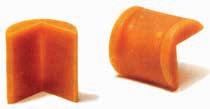
• For webbing slings and round slings
• Available with or without magnet
• Different designs and delivery time upon request
Protective sleeve for labels
Additional protective sleeve for the load capacity/lashing capacity label is available upon request. If required, the protective sleeve for the label may also be stitched onto the webbing. As lashing straps and webbing slings without labels must be decommissioned, protective sleeves for the label may significantly extend the lifespan of textile lashing and lifting equipment.


21 pewag textile lifting slings
pewag textile lashing straps and textile lifting slings
AS Protective sleeve Protective sleeve Webbing slings B2 / Cr2 mit EZD fig. 1 + 2 Webbing slings A2 fig. 5 + 6 Round slings fig. 3 + 4 Round slings Webbing slings A fig. 5 + 6 AS 38 30 mm 30 mm 1 t 1 t / 2 t AS 52 60 mm 60 mm 2 t / 3 t 3 t / 4 t AS 65 - - 4 t / 6 t 6 t / 8 t AS 75 90 mm 90 mm 8 tAS 102 120 mm 120 mm 10 t / 12 t 10 t / 12 t AS 110 150 mm 150 mm 15 t / 20 t 12 t / 20 t AS 125 180 mm 180 mm 25 t 25 t One-piece Two-piece
GS Edge wear pad Type Webbing slings Round slings GS 50 30 mmGS 90 60 mm 1 t GS 120 90 mm 2 t / 3 t GS 150 120 mm 4 t / 6 t GS 180 150 mm 8 t GS 240 180 mm 10 t
Webbing and round sling assemblies 1- and 2-leg


Standard design according to EN 1492-1
• Premium fittings in grade 10
• Reduced weight thanks to the combination of load-protecting webbing and high-strength fitting parts. Thanks to the use of coupling parts, the system allows for easy assembly by competent personnel
22 pewag textile
pewag
lashing straps and textile lifting slings
textile lifting slings
assemblies One-leg Working load limit [kg] Webbing sling B2 Width [mm] Round sling RS [t] Master link Dim. Connecting link CARW Dim. Hook HSW Dim. Length of fitting parts [mm] 1,000 30 1 MW 10 8 5-6 310 2,000 60 2 MW 13 8 7-8 360 3,000 90 3 MW 16 10 10 430 4,000 120 4 MW 18 10 10 450 6,000 - 6 MW 22 13 13 550 8,000 - 8 AW 26 16 16 720 10,000 - 10 AW 26 22 16 590
Webbing and round sling
assemblies Two-leg Working load limit –Angle of inclination ß to 45° / to 60° [kg] Webbing sling B2 Width [mm] Round sling RS [t] Master link Dim. Connecting link CARW Dim. Hook HSW Dim. Length of fitting parts [mm] 1,400 / 1,000 30 1 MW 10 8 5-6 310 2,800 / 2,000 60 2 MW 16 8 7-8 380 4,200 / 3,000 90 3 MW 18 10 10 450 5,600 / 4,000 120 4 MW 22 10 10 450 8,400 / 6,000 - 6 AW 26 13 13 570 11,200 / 8,000 - 8 AW 32 16 16 740 14,000 / 10,000 - 10 AW 32 22 16 610 Available with For more information, see p. 27
Webbing and round sling
Webbing and round sling assemblies 3- and 4-leg

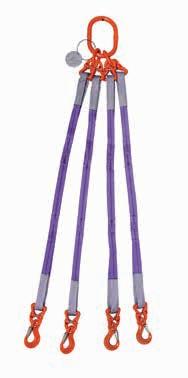
Standard design according to EN 1492-1
• Premium fittings in grade 10
• Reduced weight thanks to the combination of load-protecting webbing and high-strength fitting parts. Thanks to the use of coupling parts, the system allows for easy assembly by competent personnel
Webbing and round sling assemblies in custom designs
Customised, flexible solutions that fully reflect customer requirements.
Assemblies with different leg lengths:
Ideal to balance differences in level between lifting points.
Typical areas of application:
• Digger loading
Fully stitched-on assembly
Single legs are directly stitched onto the master link and the end fitting
Benefits:
• Further weight reduction
• Further cost reduction
• Shorter minimal lengths become possible
Combination of textile and chain
Chain within load capacity for tough applications:
• Weight reduction compared to standard chain sling
Textile within load capacity for sensitive goods
• Protects the surface of the material loaded
• Option of shortening the legs on the chain part
23 pewag textile lifting slings
pewag textile lashing straps and textile lifting slings
Webbing and
assemblies Three- or four-leg Working load limit –Angle of inclination ß to 45° / to 60° [kg] Webbing sling B2 Width [mm] Round sling RS [t] Master link Dim. Connecting link CARW Dim. Hook HSW Dim. Length of fitting parts [mm] 2,100 / 1,500 30 1 VMW 6 8 5-6 430 4,200 / 3,000 60 2 VMW 6 8 7-8 450 6,300 / 4,500 90 3 VW 7-8 10 10 520 8,400 / 6,000 120 4 VW 10 10 10 560 12,600 / 9,000 - 6 VW 13 13 13 710 16,800 / 12,000 - 8 VW 16 16 16 940 21,000 / 15,000 - 10 VW 16 22 16 810
round sling
Available with For more information, see p. 27
ED and EZD High strength fittings
• Made from age-resistant, high-strength material; may be sent back for inspections and reuse to pewag
• Easy assembly and disassembly of the demountable fitting EZD, low wear of end fittings thanks to rotatable steel bolt
• Powder coating for protection against corrosion
• Can also be used in a choke hitch
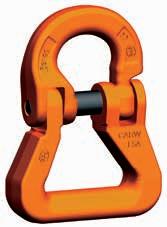
CARW Round sling connecting link
• For easy assembly of multi-leg webbing slings / round slings
• Thanks to wide surface suitable for round slings / webbing slings, no need of reducing the working load limit
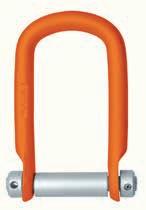
• Supplied with Connex halves, bolt and safety bush

24 pewag textile lashing straps and textile lifting slings pewag textile lifting slings
ED High strength fitting Type Suitable for sling width e [mm] b [mm] d1 [mm] Working load limit [kg] Weight [kg/pc.] ED 40 30 80 40 13 1,000 0.30 ED 75 60 125 75 16 2,500 0.70 ED 105 90 165 105 20 3,000 1.50 ED 135 120 210 135 23 4,000 2.50 ED 165 150 245 165 26 5,000 3.80 ED 195 180 300 195 30 6,000 6.10 ED 265 240 395 265 36 8,000 11.70 EZD High strength fitting Type Suitable for sling width e [mm] b [mm] d1 [mm] d2 [mm] Working load limit [kg] Weight [kg/pc.] EZD 60 60 110 60 16 20 2,000 0.70 EZD 100 90 165 100 23 25 3,000 2.00 EZD 120 120 185 120 23 25 4,000 2.50 EZD 150 150 235 150 23 35 5,000 3.20
b d1 e e b d1 d2 CARW Round sling connecting link Code for Webbing sling / Round sling Working load limit [kg] a [mm] e [mm] c [mm] d [mm] b [mm] s [mm] g [mm] Weight [kg/pc.] CARW 8 30/60 // 1 / 2 2,500 29 66 12 10 65 18 18 0.40 CARW 10 90/120 // 3 / 4 4,000 40 81 15 13 82 21 24 0.55 CARW 13 150 // 6 6,700 50 104 20 17 100 28 28 1.20 CARW 16 180 // 8 10,000 47 113 21 21 110 40 33 2.00 CARW 22 240 // 10 / 12 / 15 19,000 109 178 29 27 215 59 48 6.50 b e c a g s d
AW Master link
according to EN 1677-4 with higher load capacity
• Master link for 1-leg sling
• Master link for 2-leg sling
• Master link for 3- and 4-leg ling – only with transition link BW as in subassemblies VW
• Can also be used as end link
MW Enlarged master link
according to EN 1677-4 with higher load capacity
• Similar to master link AW, but due to larger inside dimensions suitable for next sized crane hook or special hook
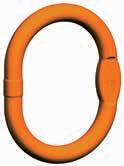


25 pewag textile lifting slings
MW Enlarged master link Code Load capacity 0–45° [kg] Can be used up to single hook acc. to DIN 15401 d [mm] t [mm] w [mm] s [mm] Weight [kg/pc.] MW 10 1,400 Nr. 2,5 11 90 65 10 0.22 MW 13 2,300 Nr. 4 14 120 70 10 0.44 MW 16 3,200 Nr. 5 16 140 80 13 0.67 MW 18 4,200 Nr. 6 19 160 95 14 1.09 MW 22 6,700 Nr. 10 23 170 105 17 1.74 MW 26 10,100 Nr. 10 27 190 110 20 2.65 MW 32 16,000 Nr. 12 33 230 130 26 4.78 MW 36 21,200 Nr. 20 38 275 150 29 7.48 MW 56 40,000 Nr. 50 56 350 250 46 21.98 AW Master link Code Load capacity 0–45° [kg] Can be used up to single hook acc. to DIN 15401 d [mm] t [mm] w [mm] s [mm] Weight [kg/pc.] AW 10 1,400 Nr. 1,6 10 80 50 10 0.14 AW 13 2,300 Nr. 2,5 13 110 60 10 0.34 AW 16 3,500 Nr. 2,5 16 110 60 14 0.58 AW 18 5,000 Nr. 5 19 135 75 14 0.92 AW 22 7,600 Nr. 6 23 160 90 17 1.59 AW 26 10,000 Nr. 8 27 180 100 20 2.46 AW 32 14,000 Nr. 10 33 200 110 26 4.04 AW 36 25,100 Nr. 16 36 260 140 29 6.22 AW 45 30,800 Nr. 25 45 340 180 - 12.82 AW 50 40,000 Nr. 32 50 350 190 43 16.60 AW 56 64,000 Nr. 32 56 400 200 - 23.30 AW 72 85,000 Nr. 50 70 460 250 - 43.11
pewag textile lashing straps and textile lifting slings
t s w d t s w d
HSW Eye sling hook
according to EN 1677-2 with higher load capacity
For pewag connex system.
To be connected by means of webbing-/ roundsling connector CARW.
• All hooks with forged safety catch

HBH webbing sling hook
• For direct and easy attachment to round slings and webbing slings. Without the need for additional components, this hook allows users to create 1-4-leg assemblies or to attach textile lifting equipment directly to the load
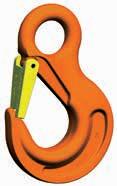
• All hooks include safety catch
• Suitable for the direct installation in round slings or webbing slings, as a connecting link or end hook
• No risk of confusion of load capacities thanks to colour scheme that reflects the colour code for textile lifting equipment

26 pewag textile
pewag textile lifting
HSW Eye sling hook Code Load capacity [kg] e [mm] h [mm] a [mm] d1 [mm] d2 [mm] g1 [mm] b [mm] Weight [kg/pc.] HSW 5/6 1,400 85 21 17 20 10 19 68 0.30 HSW 7/8 2,500 106 27 19 25 11 26 88 0.50 HSW 10 4,000 131 33 26 34 16 31 109 1.10 HSW 13 6,700 164 44 33 43 19 39 134 2.20 HSW 16 10,000 183 50 40 50 25 45 155 3.50 HSW 19/20 16,000 205 55 48 55 27 53 178 5.80 HSW 22 19,000 225 62 50 60 29 62 196 8.00
lashing straps and textile lifting slings
slings
HBH webbing sling hook Code Load capacity [kg] A [mm] B [mm] C [mm] G [mm] H [mm] P [mm] T [mm] D [mm] T2 [mm] Weight [kg/pc.] HBH 1 1,000 78 123 12 17 20 16 31 41 26 0.70 HBH 2 2,000 91 148 19 21 26 17 40 55 31 1.20 HBH 3 3,000 113 175 21 25 32 25 50 55 37 2.20 HBH 4 4,000 130 223 40 36 40 36 59 70 43 4.50 HBH 5 5,000 133 233 40 36 40 36 59 70 43 4.50 HBH 6 6,000 133 223 40 36 40 36 59 70 43 4.50 NEW e d2 h b g1 d1 a B A D G C T T2 P H
Keyfacts
Intelligent software
User-specific adaptation of object data, testing processes and steps. Automates the creation, sending and archiving of test reports. Sophisticated authorisation concept.
Save time & money
Efficient documentation of work processes, thus simplified daily workflows. Data exchange without media breaks, fault-free data communication.
Mobile solution
Direct, location-independent data access (e.g. load capacity, safety information, latest test reports etc.) Smart servicing of objects via mobile app. Offline availability.
Linked-up partnerships
Straightforward exchange and efficient interaction between service providers, merchants and customers. Improved service and data quality. Increased satisfaction and loyalty.
Always up to date
Access to the latest product data and information, overview of all test data, documentation of test procedures. Traceability of object history.
27 pewag textile lashing straps and textile lifting slings peTAG solution
& m o n ye A l w ay s up todate Link edu p pspihsrentra
Intelligent soft w are Savetime
pewag textile lashing straps
Product overview

28 Content Information about pewag textile lashing straps 30 Information about load securing 30 Lashing straps 32-49 Lashing winch 50 Accessories 51-52 Anti-slide pad 53 Nets 54 Selecting the right textile lashing equipment 55

29
pewag textile lashing straps
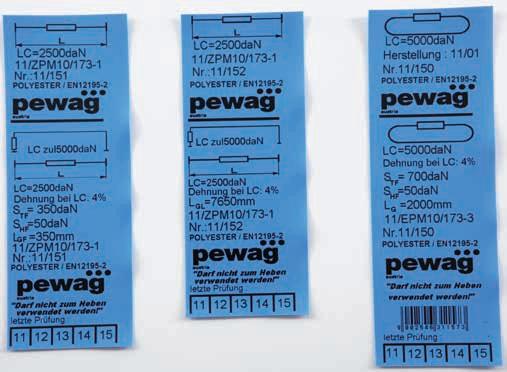
pewag textile lashing strap systems for securing loads are produced according to EN 12195-2. Lashing straps are normally applied as a one-piece lashing strap for strapping or as a two-piece lashing strap composed of a fixed end with tensioning element and end fitting and a loose end with end fitting.
Our extensive range of products ranging from a strap width of 25 to 75 mm and a lashing capacity from 250 to 10,000 daN can be further extended to suit customer’s individual needs. Each lashing strap is provided with essential technical data and user information, such like “Do not use for lifting purposes”.
Lashing strap labels:
Load securing
In the last years, load securing has become an important issue within transportation in Europe. Since public institutions have tightened up controls, the enforcement of a correct load securing will become a statutory duty in future. pewag has been for years a competent reference person to suit customer requirements. For detailed information, we offer clients a full consultancy service.
Overview:

Types, length, order text
One-piece lashing strap
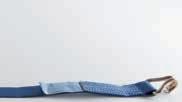
Lengths according to the corresponding standard for one- and two-piece lashing straps
Two-piece lashing strap
Two-piece fixed ends
Two-piece loose ends
Fixed end to lashing strap
Two-piece
Loose end to lashing strap
Two-piece
IGL lG
lG
Order text two-piece lashing strap:
ZG ERGO DZ 50 x 8000 / 2500 Z DHS
1 Lashing strap system with ratchet indication
2 Width of lashing strap
3 Total length
4 Admissible lashing capacity LC
5 Two-part
6 End fitting DHS
Order text one-part lashing strap:




ZG ERGO DZ 50 x 8000 / 2500 E
1 1 2 2 3 3 4 4 6 5 5 lG = lGF + IGL lGF
1 Lashing strap system with ratchet indication
2 Width of lashing strap
3 Total length
4 Admissible lashing capacity LC

30 pewag textile
pewag textile lashing
lashing straps and textile lifting slings
straps
User information: One-piece
Two-piece lashing strap
5 Single-part
One piece lashing strap (in strapping)



31
pewag textile lashing straps
pewag textile lashing straps and textile lifting slings
Long lever ERGO ratchet for higher standard tension force
Double J Hook RH 100 as end fitting
Frictional lashing
Lashing Strap ZG 75 KV
with ratchet RA 200
The high admissible lashing capacity results from the double webbing structure and allows securing even the heaviest loads with this lashing strap system. Thanks to its low weight, this lashing strap is a useful alternative to lashing chains.

Strap width 75 mm
STF
Standard tension force of the ratchet, important to determine the needed lashing straps for frictional lashing
LC – two-piece
Allowed lashing capacity of the lashing strap, important to determine the needed lashing straps for direct lashing processes
LC – one piece
Allowed lashing capacity of the lashing strap in strapping
Road transport applications:
Frictional lashing
10,000 daN
This lashing strap is not designed for frictional lashing according to EN 12195. For special applications, please contact our technical service department.
two-piece one-piece
one-piece
Accessories:
DHS 400 Delta link with eye sling hook


Order example:
D 400 Delta link
ZG 75 KV x 8000 / 10000 Z DHS
Lashing strap system 75, 2-part, with ratchet RA 200 and 2 DHS units as end fittings, strap width 75 mm Double-guided webbing, length lG = 8,000 mm
lashing straps and textile lifting slings
32 pewag textile
pewag
lashing
Direct lashing The load can be secured with 4 lashing straps Angle Dynamic friction factor 0.01 0.1 0.2 0.3 0.4 0.5 0.6 α [°] β [°] The load can be secured with 4 lashing straps [daN ~ kg] 15–35 21–30 - - - 35,250 46,900 64,350 99,150 15–35 31–40 16,000 19,550 24,700 31,950 42,150 57,950 89,500 15–35 41–50 13,450 16,650 21,350 27,900 36,200 50,000 77,600 15–35 51–60 1,050 13,300 17,450 22,400 29,300 40,800 63,800 36–50 21–30 - - 23,650 31,450 43,150 62,600 101,600 36–50 31–40 12,650 16,250 21,500 28,850 39,900 58,350 95,200 36–50 41–50 10,650 13,950 18,850 25,700 35,950 53,050 87,250 36–50 51–60 - 11,350 15,800 22,000 31,350 46,550 75,700
textile
straps
-
-
Available
For more information, see p. 27 NEW
with
lashing straps
Lashing Strap ZG 75
with ratchet RA 200
The high performance system for direct lashing of the heaviest loads covers perfectly the area between common lashing straps and lashing chains, thanks to the 75 mm width and special lengths according to customer’s needs.
Strap width
STF
Standard tension force of the ratchet, important to determine the needed lashing straps for frictional lashing
LC – two-piece
Allowed lashing capacity of the lashing strap, important to determine the needed lashing straps for direct lashing processes
LC – one piece
Allowed lashing capacity of the lashing strap in strapping

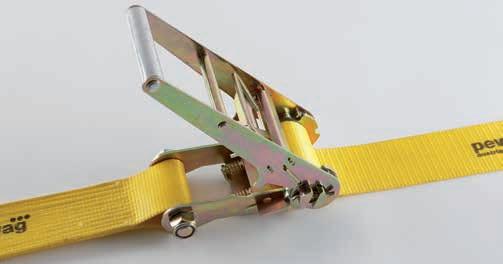


Frictional lashing
75 mm
-
This lashing strap is not designed for frictional lashing according to EN 12195. For special applications, please contact our technical service department.
Direct lashing
The
Accessories:
200
Order example:
ZG 75 x 8000 / 5000 Z DHS
33 pewag textile
pewag textile lashing straps and textile lifting slings
5,000 daN
10,000 daN
DHS
Delta
with eye
Lashing strap system 75 two-piece lashing strap, with ratchet RA 200 and 2 units DHS as end fittings, strap width 75 mm, Length lG = 8,000 mm RH 200 Double J hook D 200 Delta link Available with For more information, see p. 27
link
sling hook
Road transport applications:
load can be secured
4 lashing straps Angle Dynamic friction factor 0.01 0.1 0.2 0.3 0.4 0.5 0.6 α [°] β [°] The load can be secured with 4 lashing straps [daN ~ kg] 15-35 21-30 17,600 23,450 32,150 49,550 15-35 31-40 8,000 9,750 12,350 15,950 21,050 28,950 44,750 15-35 41-50 6,700 8,300 10,650 13,950 18,100 25,000 38,800 15-35 51-60 5,250 6,650 8,700 11,200 14,650 20,400 31,900 36-50 21-30 11,800 15,700 21,550 31,300 50,800 36-50 31-40 6,300 8,100 10,750 14,400 19,950 29,150 47,600 36-50 41-50 5,300 6,950 9,400 12,850 17,950 26,500 43,600 36-50 51-60 5,650 7,900 11,000 15,650 23,250 37,850 two-piece
two-piece one-piece
with
pewag textile lashing straps
Lashing strap ZG 50 KV
with ratchet RA ERGO-DZ 100
This heavy-load lashing strap is based on the tried-and-tested ZG 50 lashing strap range and offers a high lashing capacity for direct lashing operations thanks to its double-guided webbing. This strap offers a real alternative to smaller lashing chains while protecting the load at the same time.

Strap width
STF
Standard tension force of the ratchet, important to determine the needed lashing straps for frictional lashing
LC – two-piece
Allowed lashing capacity of the lashing strap, important to determine the needed lashing straps for direct lashing processes
LC – one piece
Allowed lashing capacity of the lashing strap in strapping
Road transport applications:
Frictional lashing
This lashing strap is not designed for frictional lashing according to EN 12195. For special applications, please contact our technical service department.
two-piece one-piece
two-piece
Accessories:
DHS 200-50
Delta link with eye sling hook
Order example:
ZG 50 KV x 8000 / 5000 Z DHS
Lashing strap system 50, two-piece lashing strap, with ratchet RA

ERGO-DZ 100 and 2 units DHS as end fittings, strap width 50 mm
Double-guided webbing, length lG = 8,000 mm
pewag textile lashing straps and textile lifting slings
34
Direct lashing
load can be secured with 4 lashing straps Angle Dynamic friction factor 0.01 0.1 0.2 0.3 0.4 0.5 0.6 α [°] β [°] The load can be secured with 4 lashing straps [daN ~ kg] 15–35 21–30 - - - 17,600 23,450 32,150 49,550 15–35 31–40 8,000 9,750 12,350 15,950 21,050 28,950 44,750 15–35 41–50 6,700 8,300 10,650 13,950 18,100 25,000 38,800 15–35 51–60 5,250 6,650 8,700 11,200 14,650 20,400 31,900 36–50 21–30 - - 11,800 15,700 21,550 31,300 50,800 36–50 31–40 6,300 8,100 10,750 14,400 19,950 29,150 47,600 36–50 41–50 5,300 6,950 9,400 12,850 17,950 26,500 43,600 36–50 51–60 - 5,650 7,900 11,000 15,650 23,250 37,850
The
Available with For more information, see p. 27 NEW
50 mm
-
5,000 daN
-
Lashing strap ZG ERGO DZ 50
with double J hook and ratchet RA ERGO-DZ 100
The user friendliest system for the lashing down of heavy loads now allows to be tensioned under pull thanks to the long lever ERGO-ratchet. The use of the maximal tensioning force (STF) reduces the required number of lashing straps and saves time when loading. Labels are very durable due to their transparent protective covers.
Strap width
STF
Standard tension force of the ratchet, important to determine the needed lashing straps for frictional lashing
LC – two-piece
Allowed lashing capacity of the lashing strap, important to determine the needed lashing straps for direct lashing processes
Road transport applications:
two-piece one-piece
two-piece
Accessories:
RH 100
Double J hook
Order example:
ZG ERGO DZ 50 x 8000 / 2500 Z RH
Lashing strap system 50, two-piece lashing strap, with ratchet RA ERGO-DZ 100 and 2 units RH as end fittings, strap width 50 mm, length lG = 8,000 mm


35
textile
pewag
lashing straps
Direct lashing
load can be secured with 4 lashing straps Angle Dynamic friction factor 0.01 0.1 0.2 0.3 0.4 0.5 0.6 α [°] β [°] The load can be secured with 4 lashing straps [daN ~ kg] 15–35 21–30 - - - 8,800 11,700 16,050 24,750 15–35 31–40 4,000 4,850 6,150 7,950 10,500 14,450 22,350 15–35 41–50 3,350 4,150 5,300 6,950 9,050 12,500 19,400 15–35 51–60 2,600 3,300 4,350 5,600 7,300 10,200 15,950 36–50 21–30 - - 5,900 7,850 10,750 15,650 25,400 36–50 31–40 3,150 4,050 5,350 7,200 9,950 14,550 23,800 36–50 41–50 2,650 3,450 4,700 6,400 8,950 13,250 21,800 36–50 51–60 - 2,800 3,950 5,500 7,800 11,600 18,900 Frictional lashing The load can be secured with 1 lashing strap Angle Dynamic friction factor 0.1 0.2 0.3 0.4 0.5 0.6 α [°] The load can be secured with 1 lashing strap [daN ~ kg] 90 100 250 450 750 1,250 2,250 85 100 240 440 740 1,240 2,240 80 100 240 440 730 1,230 2,210 70 100 230 420 700 1,170 2,110 60 90 210 380 640 1,080 1,940 50 80 190 340 570 950 1,720 40 60 160 280 480 800 1,440 30 50 120 220 370 620 1,120
pewag textile lashing straps and textile lifting slings
The
50
mm
500 daN
2,500 daN
with For more information, see p. 27
Available
Lashing strap ZG ERGO DZ 50
with delta link, eye sling hook and ratchet RA ERGO-DZ 100
The user friendliest system for the lashing down of heavy loads now allows to be tensioned under pull thanks to the long lever ERGO-ratchet. The use of the maximal tensioning force (STF) reduces the required number of lashing straps and saves time when loading. Labels are very durable due to their transparent protective covers.
Strap width
STF
Standard tension force of the ratchet, important to determine the needed lashing straps for frictional lashing
LC – two-piece
Allowed lashing capacity of the lashing strap, important to determine the needed lashing straps for direct lashing processes
Road transport applications:
50 mm
500 daN
2,500 daN
two-piece one-piece
two-piece
Accessories:
DHS 100
Delta link with eye sling hook
Order example:
ZG ERGO DZ 50 x 8000 / 2500 Z DHS
Lashing strap system 50 two-piece lashing strap, with ratchet RA ERGO-DZ 100 and 2 units DHS as end fittings, strap width 50 mm, length lG = 8,000 mm


36 pewag textile
Direct lashing The load can be secured with 4 lashing straps Angle Dynamic friction factor 0.01 0.1 0.2 0.3 0.4 0.5 0.6 α [°] β [°] The load can be secured with 4 Lashing straps [daN ~ kg] 15–35 21–30 - - - 8,800 11,700 16,050 24,750 15–35 31–40 4,000 4,850 6,150 7,950 10,500 14,450 22,350 15–35 41–50 3,350 4,150 5,300 6,950 9,050 12,500 19,400 15–35 51–60 2,600 3,300 4,350 5,600 7,300 10,200 15,950 36–50 21–30 - - 5,900 7,850 10,750 15,650 25,400 36–50 31–40 3,150 4,050 5,350 7,200 9,950 14,550 23,800 36–50 41–50 2,650 3,450 4,700 6,400 8,950 13,250 21,800 36–50 51–60 - 2,800 3,950 5,500 7,800 11,600 18,900 Frictional lashing The load can be secured with 1 lashing strap Angle Dynamic friction factor 0.1 0.2 0.3 0.4 0.5 0.6 α [°] The load can be secured with 1 Lashing strap [daN ~ kg] 90 100 250 450 750 1,250 2,250 85 100 240 440 740 1,240 2,240 80 100 240 440 730 1,230 2,210 70 100 230 420 700 1,170 2,110 60 90 210 380 640 1,080 1,940 50 80 190 340 570 950 1,720 40 60 160 280 480 800 1,440 30 50 120 220 370 620 1,120
lashing straps and textile lifting slings pewag textile lashing straps
For more
Available with
information, see p. 27
Lashing strap ZG ERGO DZ 50
other applications with ratchet RA ERGO-DZ 100
The user friendliest system for the lashing down of heavy loads now allows to be tensioned under pull thanks to the long lever ERGOratchet. The use of the maximal tensioning force (STF) reduces the required number of lashing straps and saves time when loading. Labels are very durable due to their transparent protective covers.
Standard tension force of the ratchet, important to determine the needed lashing straps for frictional lashing

– two-piece
Allowed lashing capacity of the lashing strap, important to determine the needed lashing straps for direct lashing processes
LC – one-piece strap
Allowed lashing capacity of the lashing strap in strapping


Road transport applications:
Order example:
ZG ERGO DZ 50 x 8000 / 2500 Z RHS
Lashing strap system 50 two-piece lashing strap, with ratchet RA ERGO-DZ 100 and 2 units RHS as end fittings, strap width 50 mm, length lG = 8,000 mm






37 pewag textile lashing
straps
pewag textile lashing straps and textile lifting slings
Frictional lashing The load can be secured with 1 lashing strap Angle Dynamic friction factor 0.1 0.2 0.3 0.4 0.5 0.6 α [°] The load can be secured with 1 Lashing strap [daN ~ kg] 90 100 250 450 750 1,250 2,250 85 100 240 440 740 1,240 2,240 80 100 240 440 730 1,230 2,210 70 100 230 420 700 1,170 2,110 60 90 210 380 640 1,080 1,940 50 80 190 340 570 950 1,720 40 60 160 280 480 800 1,440 30 50 120 220 370 620 1,120 Direct lashing The load can be secured with 4 lashing straps Angle Dynamic friction factor 0.01 0.1 0.2 0.3 0.4 0.5 0.6 α [°] β [°] The load can be secured with 4 Lashing straps [daN ~ kg] 15–35 21–30 - - - 8,800 11,700 16,050 24,750 15–35 31–40 4,000 4,850 6,150 7,950 11,500 10,500 22,350 15–35 41–50 3,350 4,150 5,300 6,950 9,050 12,500 19,400 15–35 51–60 2,600 3,300 4,350 5,600 7,300 10,200 15,950 36–50 21–30 - - 5,900 7,850 10,750 15,650 25,400 36–50 31–40 3,150 4,050 5,350 7,200 9,950 14,550 23,800 36–50 41–50 2,650 3,450 4,700 6,400 8,950 13,250 21,800 36–50 51–60 - 2,800 3,950 5,500 7,800 11,600 18,900 two-piece
two-piece Strap width 50 mm STF
500 daN LC
one-piece
2,500 daN
5,000 daN
DHS 100 Delta link with eye sling hook RH 100 Double J hook RHS 100 Double J hook with safety device D 100 Delta link KHF 100 Flat snap hook FH 100 Flat hook T 100 Claw hook KHG 100 Twisted snap hook Available with For more information, see p. 27
Accessories:
Lashing strap ZG ERGO-XLH 50

with ratchet RA ERGO-XLH 100
The ZG 50 lashing strap system with an extra-long lever ratchet offers high standard tension forces, thus reducing the number of lashing devices required for frictional lashing.

LC – two-piece
Allowed lashing capacity of the lashing strap, important to determine the needed lashing straps for direct lashing processes
LC – one-piece strap
Allowed lashing capacity of the lashing strap in strapping




Road transport applications: Accessories:
two-piece one-piece
Order example:
ZG ERGO-XLH 50 x 8000 / 2500 Z DHS
Lashing strap system 50 two-piece, with ratchet RA ERGO-XLH 100 and 2 units DHS as end fittings, Strap width 50 mm, length lG = 8,000 mm



38 pewag textile
lashing straps and textile lifting slings
Frictional lashing The load can be secured with 1 lashing strap Angle Dynamic friction factor 0.1 0.2 0.3 0.4 0.5 0.6 α [°] The load can be secured with 1 Lashing strap [daN ~ kg] 90 110 270 490 820 1,370 2,470 85 110 270 490 820 1,360 2,460 80 110 270 480 810 1,350 2,430 70 110 250 460 770 1,290 2,320 60 100 230 420 710 1,190 2,140 50 90 210 370 630 1,050 1,890 40 70 170 310 530 880 1,590 30 50 130 240 410 680 1,230 Direct lashing The load can be secured with 4 lashing straps Angle Dynamic friction factor 0.01 0.1 0.2 0.3 0.4 0.5 0.6 α [°] β [°] The load can be secured with 4 Lashing straps [daN ~ kg] 15–35 21–30 - - - 8,800 11,700 16,050 24,750 15–35 31–40 4,000 4,850 6,150 7,950 11,500 10,500 22,350 15–35 41–50 3,350 4,150 5,300 6,950 9,050 12,500 19,400 15–35 51–60 2,600 3,300 4,350 5,600 7,300 10,200 15,950 36–50 21–30 - - 5,900 7,850 10,750 15,650 25,400 36–50 31–40 3,150 4,050 5,350 7,200 9,950 14,550 23,800 36–50 41–50 2,650 3,450 4,700 6,400 8,950 13,250 21,800 36–50 51–60 - 2,800 3,950 5,500 7,800 11,600 18,900
pewag textile lashing straps
two-piece
Strap width 50 mm STF Standard
550 daN
tension force of the ratchet, important to determine the needed lashing straps for frictional lashing
2,500 daN
5,000 daN
DHS 100 Delta link with eye sling hook RH 100 Double J hook RHS 100 Double J hook with safety device D 100 Delta link KHF 100 Flat snap hook FH 100 Flat hook T 100 Claw hook KHG 100 Twisted snap hook
Available with For more information, see p. 27 NEW
Lashing strap ZG DOS 50
with ratchet RA DOS 100 for controllable loosening
The recommended system for lashing down unstable loads allows for the step-by-step loosening of the pre-tensioning force thanks to the purpose-built DOS ratchet and thus prevents the load from tilting.
Standard tension force of the ratchet, important to determine the needed lashing straps for frictional lashing


– two-piece
Allowed lashing capacity of the lashing strap, important to determine the needed lashing straps for direct lashing processes
LC – one-piece strap
Allowed lashing capacity of the lashing strap in strapping


two-piece one-piece
two-piece
Road transport applications: Accessories:
Order example:
ZG DOS 50 x 10000 / 2500 Z DHS
Lashing strap system 50, two-piece lashing strap, with ratchet RA DOS 100 and 2 units DHS as end fittings, strap width 50 mm, length lG = 10,000 mm






39 pewag textile
lashing straps
Frictional lashing
load can be secured with 1 lashing strap Angle Dynamic friction factor 0.1 0.2 0.3 0.4 0.5 0.6 α [°] The load can be secured with 1 Lashing strap [daN ~ kg] 90 70 170 310 520 870 1,570 85 70 170 310 520 870 1,560 80 70 170 310 510 860 3,610 70 70 160 290 490 820 1,480 60 60 150 270 450 750 1,360 50 50 130 240 400 670 1,200 40 40 110 200 330 560 1,010 30 30 80 150 260 430 780 Direct lashing
load can be secured with 4 lashing straps Angle Dynamic friction factor 0.01 0.1 0.2 0.3 0.4 0.5 0.6 α [°] β [°] The load can be secured with 4 Lashing straps [daN ~ kg] 15–35 21–30 - - - 8,800 11,700 16,050 24,750 15–35 31–40 4,000 4,850 6,150 7,950 11,500 10,500 22,350 15–35 41–50 3,350 4,150 5,300 6,950 9,050 12,500 19,400 15–35 51–60 2,600 3,300 4,350 5,600 7,300 10,200 15,950 36–50 21–30 - - 5,900 7,850 10,750 15,650 25,400 36–50 31–40 3,150 4,050 5,350 7,200 9,950 14,550 23,800 36–50 41–50 2,650 3,450 4,700 6,400 8,950 13,250 21,800 36–50 51–60 - 2,800 3,950 5,500 7,800 11,600 18,900
pewag textile lashing straps and textile lifting slings
The
The
Strap width 50 mm STF
350 daN LC
2,500 daN
5,000 daN
DHS 100 Delta link with eye sling hook RH 100 Double J hook RHS 100 Double J hook with safety device D 100 Delta link FPH 100 Single J hook with ratchet fitting KHF 100 Flat snap hook FH 100 Flat hook T 100 Claw hook KHG 100 Twisted snap hook
Available with For more information, see p. 27
Lashing strap ZG 50
with ratchet RA 100
The most versatile system for friction lashing and economical direct lashing of heavy loads offers a high standard tension force (STF) and is the ideal 5-tonnes-strap for professional applications due to the special lengths and the extensive range of accessories.
Standard tension force of the ratchet, important to determine the needed lashing straps for frictional lashing
Allowed lashing capacity of the lashing strap, important to determine the needed lashing straps for direct lashing processes
Allowed lashing capacity of the lashing strap in strapping

Road transport applications:
two-piece one-piece two-piece
Accessories: RH 100 Double J hook RHS 100 Double J hook with safety device








sling D 100 Delta link FPH 100 Single J hook with ratchet fitting
Order example:
ZG 50 x 8000 / 2500 Z DHS
KHF 100 Flat snap hook FH 100 Flat hook T 100 Claw hook KHG 100 Twisted snap hook Available with For more information, see p. 27

40 pewag textile
lashing straps and textile lifting slings
Frictional lashing
load can be secured with 1 lashing strap Angle Dynamic friction factor 0.1 0.2 0.3 0.4 0.5 0.6 α [°] The load can be secured with 1 Lashing strap [daN ~ kg] 90 70 170 310 520 870 1,570 85 70 170 310 520 870 1,560 80 70 170 310 510 860 3,610 70 70 160 290 490 820 1,480 60 60 150 270 450 750 1,360 50 50 130 240 400 670 1,200 40 40 110 200 330 560 1,010 30 30 80 150 260 430 780 Direct lashing
load can be secured with 4 lashing straps Angle Dynamic friction factor 0.01 0.1 0.2 0.3 0.4 0.5 0.6 α [°] β [°] The load can be secured with 4 Lashing straps [daN ~ kg] 15–35 21–30 - - - 8,800 11,700 16,050 24,750 15–35 31–40 4,000 4,850 6,150 7,950 11,500 10,500 22,350 15–35 41–50 3,350 4,150 5,300 6,950 9,050 12,500 19,400 15–35 51–60 2,600 3,300 4,350 5,600 7,300 10,200 15,950 36–50 21–30 - - 5,900 7,850 10,750 15,650 25,400 36–50 31–40 3,150 4,050 5,350 7,200 9,950 14,550 23,800 36–50 41–50 2,650 3,450 4,700 6,400 8,950 13,250 21,800 36–50 51–60 - 2,800 3,950 5,500 7,800 11,600 18,900
pewag textile lashing straps
The
The
Strap width 50 mm STF
350 daN LC
– two-piece
2,500 daN LC
– one-piece strap
5,000 daN
DHS 100 Delta link with eye
Lashing strap system 50, two-piece lashing strap, with ratchet RA 100 and 2 units DHS as end fittings, strap width 50 mm, length lG = 8,000 mm hook
Lashing strap ZG 50 VB

with ratchet RA ERGO-DZ 100
Increased wear resistance thanks to the extra-densely woven webbing. Lashing straps with wear-resistant webbing come with stitched-on label protection sleeve. May be combined with all ratchets and end fittings from the ZG 50 mm range.
STF
Standard tension force of the ratchet, important to determine the needed lashing straps for frictional lashing


LC – two-piece
Allowed lashing capacity of the lashing strap, important to determine the needed lashing straps for direct lashing processes
LC – one-piece strap
Allowed lashing capacity of the lashing strap in strapping



Road transport applications:
two-piece one-piece two-piece
Order example:
ZG ERGO DZ 50 VB x 8000 / 2500 Z DHS
Lashing strap system 50, two-piece lashing strap, with ratchet RA ERGO-DZ 100 and 2 units DHS as end fittings, strap width 50 mm, length lG = 8,000 mm made of wear-resistant webbing




41
pewag textile lashing straps
Frictional lashing The load can be secured with 1 lashing strap Angle Dynamic friction factor 0.1 0.2 0.3 0.4 0.5 0.6 α [°] The load can be secured with 1 Lashing strap [daN ~ kg] 90 100 250 450 750 1,250 2,250 85 100 240 440 740 1,240 2,240 80 100 240 440 730 1,230 2,210 70 100 230 420 700 1,170 2,110 60 90 210 380 640 1,080 1,940 50 80 190 340 570 950 1,720 40 60 160 280 480 800 1,440 30 50 120 220 370 620 1,120 Direct lashing The load can be secured with 4 lashing straps Angle Dynamic friction factor 0.01 0.1 0.2 0.3 0.4 0.5 0.6 α [°] β [°] The load can be secured with 4 Lashing straps [daN ~ kg] 15–35 21–30 - - - 8,800 11,700 16,050 24,750 15–35 31–40 4,000 4,850 6,150 7,950 11,500 10,500 22,350 15–35 41–50 3,350 4,150 5,300 6,950 9,050 12,500 19,400 15–35 51–60 2,600 3,300 4,350 5,600 7,300 10,200 15,950 36–50 21–30 - - 5,900 7,850 10,750 15,650 25,400 36–50 31–40 3,150 4,050 5,350 7,200 9,950 14,550 23,800 36–50 41–50 2,650 3,450 4,700 6,400 8,950 13,250 21,800 36–50 51–60 - 2,800 3,950 5,500 7,800 11,600 18,900
pewag textile lashing straps and textile lifting slings
50 mm
Strap width
500 daN
2,500 daN
5,000 daN
DHS 100 Delta link with eye
hook RH 100 Double J hook RHS 100 Double J hook with safety device D 100 Delta link FPH 100 Single J hook with ratchet fitting KHF 100 Flat snap hook FH 100 Flat hook T 100 Claw hook KHG 100 Twisted snap hook Available with For more information, see p. 27
Accessories:
sling
Lashing strap ZG 50 ... 2000
with ratchet RA 100
The classic system for the lashing down of medium-heavy loads. The standard system is the “4-ton-strap” with a round hook in 8 m and 10 m length, available promptly ex warehouse.
Standard tension force of the ratchet, important to determine the needed lashing straps for frictional lashing
Allowed lashing capacity of the lashing strap, important to determine the needed lashing straps for direct lashing processes
Allowed lashing capacity of the lashing strap in strapping
Road transport applications:
two-piece one-piece two-piece
Accessories:
RH 100
Double J hook
Order example:
ZG 50 x 8000 / 2000 Z RH
Lashing strap system 50, two-piece lashing strap, with ratchet RA 100 and 2 units RH as end fittings, strap width 50 mm, length lG = 8,000 mm

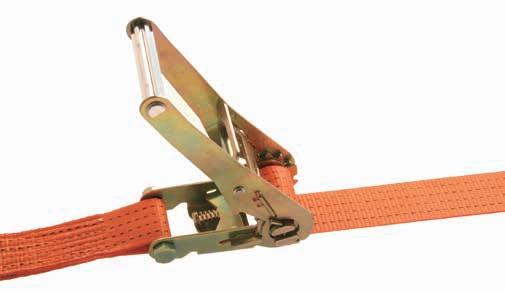
or ZG 50 x 10000 / 2000 Z RH
Lashing strap system 50, two-piece lashing strap, with ratchet RA 100 and 2 units RH as end fittings, strap width 50 mm, length lG = 10,000 mm

42 pewag textile
Frictional lashing The load can be secured with 1 lashing strap Angle Dynamic friction factor 0.1 0.2 0.3 0.4 0.5 0.6 α [°] The load can be secured with 1 Lashing strap [daN ~ kg] 90 70 180 320 540 900 1,620 85 70 170 320 530 890 1,610 80 70 170 310 530 880 1,590 70 70 160 300 500 840 1,520 60 60 150 280 460 770 1,400 50 50 130 240 410 680 1,240 40 40 110 200 340 570 1,040 30 30 90 160 270 450 800 Direct lashing
load can be secured with 4 lashing straps Angle Dynamic friction factor 0.01 0.1 0.2 0.3 0.4 0.5 0.6 α [°] β [°] The load can be secured with 4 Lashing straps [daN ~ kg] 15–35 21–30 - - - 7,050 9,350 12,850 19,800 15–35 31–40 3,200 3,900 4,900 6,350 8,400 11,550 17,900 15–35 41–50 2,650 3,300 4,250 5,550 7,200 10,000 15,500 15–35 51–60 2,100 2,650 3,450 4,450 5,850 8,150 12,750 36–50 21–30 - - 4,700 6,250 8,600 12,500 20,300 36–50 31–40 2,500 3,250 4,300 5,750 7,950 11,650 19,000 36–50 41–50 2,100 2,750 3,750 5,100 7,150 10,600 17,450 36–50 51–60 - 2,250 3,150 4,400 6,250 9,300 15,100
lashing straps and textile lifting slings pewag textile lashing straps
The
Strap width 50 mm STF
360 daN LC
– two-piece
2,000 daN LC
– one-piece strap
4,000 daN
Lashing strap ZG 35

with ratchet RA 40
The handy system for lashing down and direct lashing of light loads for commercial purposes and light trailers is characterized by a smaller strap width. Normally used with double J hooks and a length of 6 m.

Standard tension force of the ratchet, important to determine the needed lashing straps for frictional lashing
LC – two-piece
Allowed lashing capacity of the lashing strap, important to determine the needed lashing straps for direct lashing processes
LC – one-piece strap
Allowed lashing capacity of the lashing strap in strapping

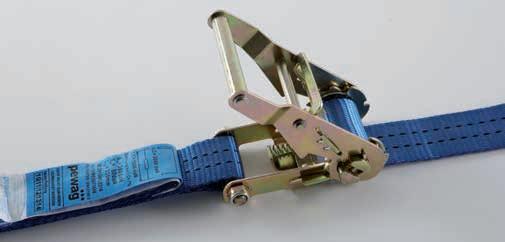

Road transport applications:
two-piece one-piece
two-piece
Accessories:
Order example:
ZG 35 x 6000 / 1000 Z DKR
Lashing strap system 35, two-piece lashing strap, with ratchet RA 40 and 2 units DKR as end fittings, strap width 35 mm, length lG = 6,000 mm
43 pewag textile
lashing straps
pewag textile lashing straps and textile lifting slings
Frictional lashing The load can be secured with 1 lashing strap Angle Dynamic friction factor 0.1 0.2 0.3 0.4 0.5 0.6 α [°] The load can be secured with 1 Lashing strap [daN ~ kg] 90 60 140 250 420 700 1,260 85 50 130 250 410 690 1,250 80 50 130 240 410 680 1,240 70 50 130 230 390 650 1,180 60 50 120 210 360 600 1,090 50 40 100 190 320 530 960 40 30 80 160 260 440 800 30 30 70 120 210 350 630 Direct lashing The load can be secured with 4 lashing straps Angle Dynamic friction factor 0.01 0.1 0.2 0.3 0.4 0.5 0.6 α [°] β [°] The load can be secured with 4 Lashing straps [daN ~ kg] 15–35 21–30 - - - 3,500 4,650 6,400 9,900 15–35 31–40 1,600 1,950 2,450 3,150 4,200 5,750 8,950 15–35 41–50 1,300 1,650 2,100 2,750 3,600 5,000 7,750 15–35 51–60 1,050 1,300 1,700 2,200 2,900 4,050 6,350 36–50 21–30 - - 2,350 3,100 4,300 6,250 10,150 36–50 31–40 1,250 1,600 2,150 2,850 3,950 5,800 9,500 36–50 41–50 1,050 1,350 1,850 2,550 3,550 5,300 8,700 36–50 51–60 - 1,100 1,550 2,200 3,100 4,650 7,550
Strap width 35 mm
STF
280 daN
1,000 daN
2,000 daN
DKR 50 Delta link with snap hook RH 50 Double J hook D 40 Delta link
Lashing strap ZG 48

with ratchet RA 20
The special system for truck interior lashing of light loads between lashing rails by means of the E truck fitting is thanks to the ratchet also suitable for general applications if equipped with double J hooks.
Standard tension force of the ratchet, important to determine the needed lashing straps for frictional lashing

Allowed lashing capacity of the lashing strap, important to determine the needed lashing straps for direct lashing processes
the
Road transport applications:
two-piece one-piece
Accessories:
SZ 20
E truck fitting
Order example:
RH 100 Double J hook
ZG 48 x 3900 / 800 Z SZ
Lashing strap system 48, two-piece lashing strap, with ratchet RA 20 and 2 units SZ as end fittings, strap width 48 mm, length lG = 3,900 mm

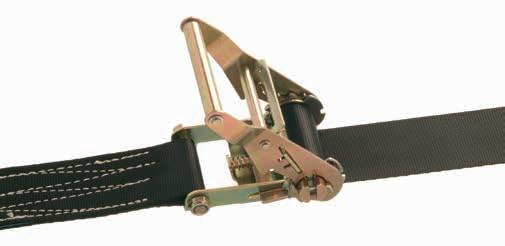
44 pewag textile
and textile
Frictional lashing
load can be secured with 1 lashing strap Angle Dynamic friction factor 0.1 0.2 0.3 0.4 0.5 0.6 α [°] The load can be secured with 1 Lashing strap [daN ~ kg] 90 60 150 270 450 750 1,350 85 60 140 260 440 740 1,340 80 60 140 260 440 730 1,320 70 60 140 250 420 700 1,260 60 50 120 230 380 640 1,160 50 40 110 200 340 570 1,030 40 40 90 170 280 480 860 30 30 70 130 220 370 670 Direct lashing
load can be secured with 4 lashing straps Angle Dynamic friction factor 0.01 0.1 0.2 0.3 0.4 0.5 0.6 α [°] β [°] The load can be secured with 4 Lashing straps [daN ~ kg] 15–35 21–30 - - - 2,800 3,750 5,150 7,900 15–35 31–40 1,250 1,550 1,950 2,550 3,350 4,600 7,150 15–35 41–50 1,050 1,300 1,700 2,200 2,850 4,000 6,200 15–35 51–60 800 1,050 1,350 1,750 2,300 3,250 5,100 36–50 21–30 - - 1,850 2,500 3,450 5,000 8,100 36–50 31–40 1,000 1,300 1,700 2,300 3,150 4,650 7,600 36–50 41–50 850 1,100 1,500 2,050 2,850 4,200 6,950 36–50 51–60 - 900 1,250 1,750 2,500 3,700 6,050
lashing straps
lifting slings pewag textile lashing straps
The
The
two-piece
Strap
48 mm STF
width
300 daN LC
two-piece
800 daN LC – one-piece strap
1,600 daN
–
Allowed lashing capacity of
lashing strap in strapping
Lashing strap ZG SP 48 with tightener SP 20

The special system with E truck fitting for truck interior lashing of light loads can be fixed between the lashing rails in a very short time thanks to the SP 20 tightener.
Strap width
STF
Standard tension force of the ratchet, important to determine the needed lashing straps for frictional lashing

LC – two-piece
Allowed lashing capacity of the lashing strap, important to determine the needed lashing straps for direct lashing processes
LC – one-piece strap
Allowed lashing capacity of the lashing strap in strapping

Accessories:
48 mm
-
800 daN
-
Order example:
ZG SP 48 x 3900 / 800 Z SZ
Lashing strap system 48, two-piece lashing strap, with tightener SP 20 and 2 units SZ as end fittings, strap width 48 mm, length lG = 3,900 mm

45
textile
pewag
lashing straps
pewag textile lashing straps and textile lifting slings
SZ 20 E truck fitting RH 100 Double J hook
Lashing strap ZG KL 35
with cam buckle KL 14
The one-piece system with a strong cam buckle is suitable for securing and bundling very light loads in order to form loading units.
Strap width
STF
Standard tension force of the ratchet, important to determine the needed lashing straps for frictional lashing
LC – two-piece
Allowed lashing capacity of the lashing strap, important to determine the needed lashing straps for direct lashing processes
in strapping
Road transport applications:
35 mm
one-piece
Order example:
ZG KL 35 x 5000 / 700 E
Lashing strap system 35, one-piece lashing strap, with cam buckle KL 14 and strap width 35 mm, length lG = 5,000 mm
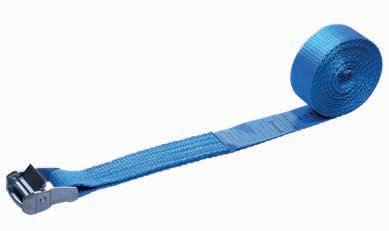

46 pewag textile
Direct lashing The load can be secured with 4 lashing straps Angle Dynamic friction factor 0.01 0.1 0.2 0.3 0.4 0.5 0.6 α [°] β [°] The load can be secured with 4 Lashing straps [daN ~ kg] 15–35 21–30 - - - 2,450 3,250 4,500 6,900 15–35 31–40 1,100 1,350 1,700 2,200 2,950 4,050 6,250 15–35 41–50 900 1,150 1,450 1,950 2,500 3,500 5,400 15–35 51–60 700 900 1,200 1,550 2,050 2,850 4,450 36–50 21–30 - - 1,650 2,200 3,000 4,350 7,100 36–50 31–40 850 1,100 1,500 2,000 2,750 4,050 6,650 36–50 41–50 700 950 1,300 1,800 2,500 3,700 6,100 36–50 51–60 - 750 1,100 1,500 2,150 3,250 5,300
lashing straps and textile lifting slings pewag textile lashing straps
-
-
one-piece strap
lashing
lashing strap
700 daN
LC –
Allowed
capacity of the
Lashing strap ZG 25
with ratchet RA 10
Our space-saving lashing strap system is ideal for direct lashing of very light loads in cars and on roof racks providing also for private purposes safe transportation according to regulations. Available with double J hook and a length of 4 m or as one-piece lashing strap with a length of 5 m. Strap width
Standard tension force of the ratchet, important to determine the needed lashing straps for frictional lashing
Allowed lashing capacity of the lashing strap, important to determine the needed lashing straps for direct lashing processes
LC – one-piece strap
Allowed lashing capacity of the lashing strap in strapping

Road transport applications:
Frictional lashing
500 daN
This lashing strap is not designed for frictional lashing according to EN 12195. For special applications, please contact our technical service department.
two-piece one-piece
two-piece
Accessories:
Order example:
ZG 25 x 4000 / 250 Z RH
Lashing strap system 25, two-piece lashing strap, with ratchet RA 10, strap width 25 mm and RH as end fittings, length lG = 4,000 mm




47
textile lashing
pewag
straps
pewag textile lashing straps and textile lifting slings
Direct lashing The load can be secured with 4 lashing straps Angle Dynamic friction factor 0.01 0.1 0.2 0.3 0.4 0.5 0.6 α [°] β [°] The load can be secured with 4 Lashing straps [daN ~ kg] 15–35 21–30 - - - 850 1,150 1,600 2,450 15–35 31–40 400 450 600 750 1,050 1,400 2,200 15–35 41–50 300 400 500 650 900 1,250 1,900 15–35 51–60 250 300 400 550 700 1,000 1,550 36–50 21–30 - - 550 750 1,050 1,550 2,500 36–50 31–40 300 400 500 700 950 1,450 2,350 36–50 41–50 250 300 450 600 850 1,300 2,150 36–50 51–60 - 250 350 550 750 1,150 1,850
25
mm STF
LC
– two-piece
250 daN
S-hook RH 10 Double J hook D 10 Delta link
ZSH 10
Lashing strap ZG KL 25
with cam buckle KL 5
Our smallest lashing system according to load securing standards is ideal for securing and bundling very light loads in cars and for luggage lashing, available as a one-piece lashing strap with cam buckle and a length of 5 m.
Strap width
STF
Standard tension force of the ratchet, important to determine the needed lashing straps for frictional lashing
LC – two-piece
Allowed lashing capacity of the lashing strap, important to determine the needed lashing straps for direct lashing processes
LC – one-piece strap
Road transport applications:
Frictional lashing
25 mm
This lashing strap is not designed for frictional lashing according to EN 12195. For special applications, please contact our technical service department.
two-piece one-piece
two-piece
Order example:
ZG KL 25 x 5000 / 250 E
250 daN Angle Dynamic friction factor 0.01 0.1 0.2 0.3 0.4 0.5 0.6 α [°] β [°] The load can be secured with 4 lashing straps [daN ~ kg] 15–35 21–30 - - - 850 1,150 1,600 2,450 15–35 31–40 400 450 600 750 1,050 1,400 2,200 15–35 41–50 300 400 500 650 900 1,250 1,900 15–35 51–60 250 300 400 550 700 1,000 1,550 36–50 21–30 - - 550 750 1,050 1,550 2,500 36–50 31–40 300 400 500 700 950 1,450 2,350 36–50 41–50 250 300 450 600 850 1,300 2,150 36–50 51–60 - 250 350 550 750 1,150 1,850
Lashing strap system 25, one-piece lashing strap, with cam buckle KL 5 and strap width 25 mm, length lG = 5,000 mm

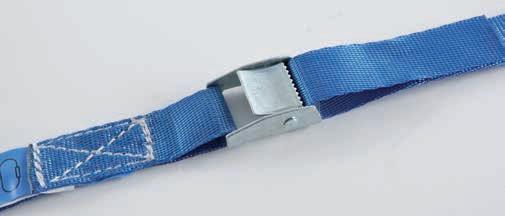
48 pewag textile
lashing straps and textile lifting slings pewag textile lashing straps
-
-
Allowed lashing capacity of the lashing strap in strapping Direct lashing The load can be secured with 4 lashing straps
Lashing strap ZG Roll
Quick-action lashing strap with ratchet and round hook. For the fast and simple securing of loads in passenger cars or trailers. Thanks to its ratchet system, the lashing strap may be rolled up at the touch of a button.
tension force of the ratchet, important to determine the needed lashing straps for frictional lashing
– two-piece
Allowed lashing capacity of the lashing strap, important to determine the needed lashing straps for direct lashing processes
LC – one-piece strap
Allowed lashing capacity of the lashing strap in strapping

Road transport applications:
two-piece one-piece two-piece
Order example:
ZG Roll 50 x 3000 / 750 RH
Lashing strap system ZG Roll with ratchet and Double J hook Strap width 50 mm, length lG = 3,000 mm
49 pewag textile lashing
straps
pewag textile lashing straps and textile lifting slings
Frictional lashing The load can be secured with 1 lashing strap Angle Dynamic friction factor 0.1 0.2 0.3 0.4 0.5 0.6 α [°] The load can be secured with 1 lashing strap [daN ~ kg] 90 10 30 60 110 180 330 85 10 30 60 110 180 330 80 10 30 60 110 180 330 70 10 30 60 100 170 310 60 10 30 50 90 160 290 50 10 20 50 80 140 250 40 10 20 40 70 120 210 30 - 10 30 50 90 160 Direct lashing The load can be secured with 4 lashing straps Angle Dynamic friction factor 0.01 0.1 0.2 0.3 0.4 0.5 0.6 α [°] β [°] The load can be secured with 4 lashing straps [daN ~ kg] 15–35 21–30 - - - 2,600 3,500 4,800 7,400 15–35 31–40 1,200 1,450 1,850 2,350 3,150 4,300 6,700 15–35 41–50 1,000 1,250 1,600 2,050 2,700 3,750 5,800 15–35 51–60 750 1,000 1,300 1,650 2,150 3,050 4,750 36–50 21–30 - - 1,750 2,350 3,200 4,650 7,600 36–50 31–40 900 1,200 1,600 2,150 2,950 4,350 7,100 36–50 41–50 750 1,000 1,400 1,900 2,650 3,950 6,500 36–50 51–60 - 850 1,150 1,650 2,350 3,450 5,650
Strap
50 mm STF
75 daN LC
width
Standard
750 daN
-
Lashing winch ZW 50 x 10000 / 2500
incl. crank, for the securing of loads acc. to EN 12195
• Especially for the transport of long timber
• Admissible lashing capacity (LC) for straight pull: 2,500 daN Version with tensioning rod or ratchet is available upon request
• The standard version of the lashing winch comes with yellow, wear resistant webbing, protective sleeve for the labels and loop reinforcement

Road transport applications:
two-piece one-piece
Direct lashing
Lashing strap is not designed for direct lashing. For special applications, please contact our technical service department.
Order example:
ZW 50 x 10000 / 2500 D
lashing winch system 50 incl. crank and Delta link
Strap width 50 mm, length lG = 10,000 mm
50 pewag textile
lashing straps and textile lifting slings pewag textile lashing straps
Strap width 50 mm LC – one-piece strap 2,500 daN LC – in strapping 5,000 daN Standard tensioning force STF [daN] for unrolled length [m] 500 6 600 7 750 8 850 9
lashing The load can be secured with 1 lashing strap Angle Dynamic friction factor 0.1 0.2 0.3 0.4 0.5 0.6 α [°] The load can be secured with 1 lashing strap [daN ~ kg] 90 180 420 760 1,270 2,120 3,820 85 180 420 760 1,270 2,110 3,810 80 170 410 750 1,250 2,090 3,760 70 170 390 710 1,190 1,990 3,590 60 150 360 660 1,100 1,840 3,310 50 130 320 580 970 1,620 2,930 40 110 270 490 810 1,360 2,450 30 90 210 380 630 1,060 1,910
Frictional
Available with For more information, see p. 27
AS Gummed protective sleeve
• Gummed, ideal for rough surfaces
• For sharp edges, we recommend to use an edge protector or a edge wear pad GS
• The standard design is not sewed on the sling, so the sleeve can be moved along the sling. On request also available sewed on the material of the sling
GS Edge wear pad
• Three-layer, therefore very effective
• made of Polyester PES
• Length 500 mm, special lengths and special widths on upon request

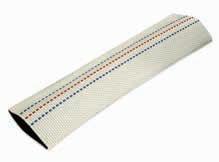
GS Edge wear pad
Protective sleeve for labels
Additional protective sleeve for the load capacity/lashing capacity label is available upon request. If required, the protective sleeve for the label may also be stitched onto the webbing. As lashing straps and webbing slings without labels must be decommissioned, protective sleeves for the label may significantly extend the lifespan of textile lashing and lifting equipment.



51 pewag textile lashing straps
pewag textile lashing straps and textile lifting slings
Type Lashing strap system [mm] AS 38 25 / 35 AS 52 48 / 50 AS 65 75
AS Protective sleeve
Type Lashing strap system [mm] GS 50 25 / 35 GS 75 48 / 50 GS 90 75
KSPAD Edge protection pad
• With slits for inserting straps up to a width of 50 mm
• May also be used as a base for the ratchet to protect the loaded goods
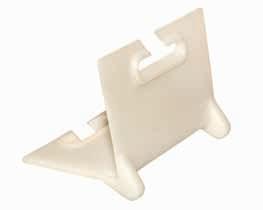
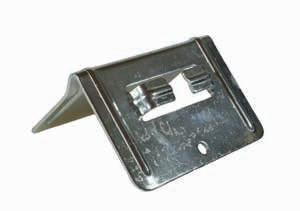
KSM Edge protection made of metal
• Protection for the strap and loaded goods thanks to large-surface pressure distribution
• May be used for straps up to a width of 50 mm
KSP Edge protection made of PVC
• Protection for the strap and loaded goods thanks to large-surface pressure distribution
• May be used for straps up to a width of 50 mm
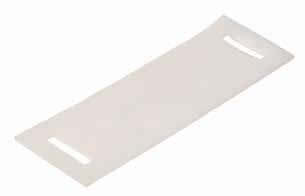
KSSCH Edge protection rail
• High stability thanks to double-moulded units
• Ideal for securing and protecting goods on pallets
• Available in a range of standard lengths; custom designs available upon request
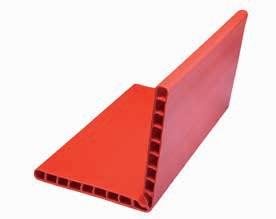
52 pewag textile lashing straps and textile lifting slings pewag textile lashing straps
NEW NEW
ARM Anti-slide pad
Durable anti-slip mats; ideal for securing loads. Reduces the number of lashing straps required for lashing-down operations by increasing the dynamic friction factor.
Tested anti-slip mats; ideal for securing commercial loads. Useable for loads up to 82.50 t / m2

Friction factor with 10 t / m2 depending on the friction partner up to 1.49 µ. Extremely robust and designed for multiple use. Sealed surface means that no liquid is able to penetrate the material, thereby also preventing frost formation. Available in a pre-cut design with 20 x 24 cm. Other dimensions and/or complete rolls are available upon request.
1 with ARM anti-slip mat
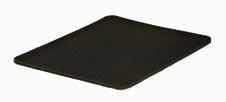
2 Concrete on concrete (no intermediate layer)
3 Concrete on wood (with wooden intermediate layer)
4 Big Bags on wooden pallets
5 Euro pallets (wood) on plywood
6 Oiled steel plates on oiled steel plates
53 pewag textile lashing straps
pewag textile lashing straps and textile lifting slings
2,500 2,000 1,500 1,000 500 0 0.6 1,940 µ kg 0.5 1,080 0.4 640 0.2 210 0.3 380 0.1 90 Anti-slide pad Type dimensions [mm] thickness [mm] friction coefficient weigth [kg/pc.] ARM 10 x 20 100 x 200 8 µ > 0.60 0.15 ARM 20 x 20 200 x 200 8 µ > 0.60 0.30 ARM 20 x 24 200 x 240 4.50 µ > 0.60 0.10 Example:
of
α
RA ERGO DZ 100 (STF=500
load to be lashed down with 1 lashing strap:
Angle
inclination
= 60° and ratchet
daN)
1 2 3 4 5 6 NEW
Load-securing nets
• Ideal for securing divided and palleted loads and/or to divide the loading space
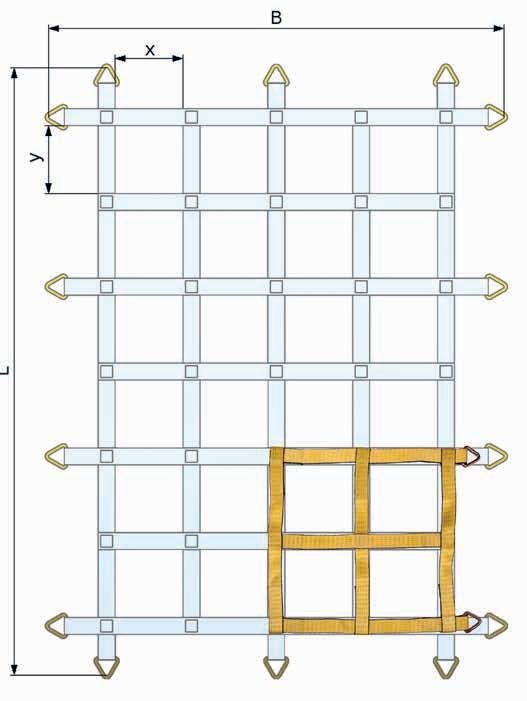
• Available in a range of dimensions with strap widths from 25 to 50 mm for use in trucks, vans and passenger cars
• In combination with our tried-and-tested pewag lashing strap programme, we are able to provide complete load-securing solutions with our nets and tensioning elements
Cargo nets
Knotted cover nets made from polypropylene and including a tension cord serve to secure loads primarily in passenger cars, on pallets or on trailers. Available in different dimensions and rope thicknesses.
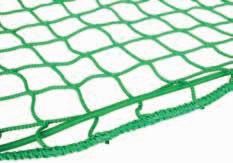
Cargo net with tension line, made of polypropylene, loose packed

54 pewag textile
pewag textile lashing
lashing straps and textile lifting slings
straps
dimensions [mm] detail 1,250 x 2,100 rope 3 mm, width of mesh 45 mm 1,500 x 2,500 rope 3 mm, width of mesh 45 mm 2,000 x 3,000 rope 6 mm, width of mesh 45 mm 2,500 x 3,500 rope 6 mm, width of mesh 45 mm 3,000 x 3,500 rope 6 mm, width of mesh 45 mm 3,000 x 4,000 rope 6 mm, width of mesh 45 mm 3,500 x 5,000 rope 6 mm, width of mesh 45 mm 3,500 x 6,000 rope 6 mm, width of mesh 45 mm
NEW NEW
Selecting
the right textile lifting equipment
The correct working load limit
All our webbing slings and round slings are labelled with their load capacity in accordance with EN 1492. However, the load capacity also depends on the type of application.
Let’s take a 3 t round sling as an example:
Selecting the right textile lashing equipment
Type of lashing application
Frictional lashing
For securing heavy loads, a high STF value is important.
• Use at least 2 lashing straps
Edge-loading
Textile lifting equipment must be protected against sharp edges, friction and abrasion caused by the load/the hook in order to guarantee safety and a long lifespan.
Areas of application
Different materials have different properties. pewag lifting straps and round slings are made from polyester and therefore subject to the following limitations:
• Working temperature: -40 °C bis 100 °C – In temperatures below 0 °C, damp lifting devices may not be used to prevent ice formation
• Use in acids and caustic solutions or exposure to their vapours is not permitted
Term of expiration
PES is photo- and heat-stabilised and is not subject to any term of expiration. The terms of expiration that used to be mandatory no longer apply; i.e. the manufacturing date that is printed on the label is not relevant for usage.
Direct lashing
For securing heavy loads, a high LC value is important.
• Use at least 2 pairs of lashing straps
Size, shape and weight of the load determine the selection and application of textile lashing equipment. For instance, long timber is secured exclusively by frictional lashing, whereas heavy vehicles are more effectively secured by direct lashing.
Edge-loading
We speak of edge-loading if the radius of the edge is smaller than the belt density. If this is the case, abrasion and/or edge protection must be used. Abrasion protection may also significantly extend the lifespan of a lashing strap, for instance on rough surfaces.
Areas of application
Lashing straps are made from different materials, all of which have different properties. pewag lashing straps are made from polyester (PES) and therefore subject to the following limitations:
• Working temperature: -40 °C bis +120 °C – In temperatures of below 0 °C, damp lashing devices may not be used to prevent ice formation
• Use in acids and caustic solutions or exposure to their vapours is not permitted
Term of expiration
PES is photo- and heat-stabilised and is not subject to any term of expiration. The terms of expiration that used to be mandatory no longer apply; i.e. the manufacturing date that is printed on the label is not relevant for usage.
55 pewag textile lashing straps
pewag textile lashing straps and textile lifting slings
100 % 3,000 kg 140 % 4,200 kg 80 % 2,400 kg 100 % 3,000 kg 200 % 6,000 kg 100 % 3,000 kg
User manual
for pewag textile lashing straps

56
User manual User manual for pewag textile lashing straps 58-59 Explanation of pewag tables 59-61 pewag Laser-protractor 61 Dynamic friction factors 61-62 User manual for pewag textile webing slings and round slings 62-63

User manual
This user manual provides information about the use, storage, inspection and maintenance of pewag textile lashing straps.
General information
pewag textile lashing straps are designed for securing the load during its transport. If properly used, pewag textile lashing straps have a long service life and offer a high degree of safety. Nevertheless, personal injury and material damage can only be prevented by proper use. It is therefore of vital importance to read and understand this manual before the product is put into service. However, this does not exclude a responsible and attentive use of textile lashing straps when securing the load. Although pewag offers the necessary help means for the correct selection and application of lashing straps, adequate professional knowledge is required. pewag textile lashing straps must therefore only be used by competent personnel.
Modification of the original condition
A modification of the original condition of this product is not permitted – e.g. by bending, grinding, dividing parts, boring, etc. Moreover, they must not be subjected to temperature influences above 100 °C.
For safety reasons, it is not permitted to remove safety devices like triggers, safety pins, safety catches, safety bushes, etc. Surface coating procedures like hot dip galvanizing or electrogalvanizing are not permitted. Stripping and pickling are also dangerous processes and must not be carried out without the approval of pewag. In case of doubt, please contact our technical service department.
Storage
pewag textile lashing straps must be stored clean, dry and protected from corrosion.
Inspections
Before the first use, following criteria must be satisfied:
• the delivered lashing strap corresponds to the ordered product
• the information given by the marking and the lashing capacity on the label coincide with the designated application
• the lashing strap is provided with the corresponding file
• this operating manual is available and was read and understood by the user
Lashing straps must be checked before each use for visible signs of damage or wear. In the case of doubt or damage, they must be taken out of service and inspected by a competent person.
An inspection according to national regulations must be carried out at least once a year by a competent person. However, this period must be shortened in view of the conditions of use – e.g. in case of frequent or rough use.
After extraordinary events (e.g. uncontrolled temperature influence, emergency braking etc.) which could affect the safe working condition, the lashing strap must be inspected by a qualified person.
Withdrawal criteria for the visual inspection
The lashing strap must be taken out of service if one or more of the following criteria are met:
• Broken parts or broken fibres / seams
• Missing or illegible marking on the label
• Deformation of accessories
• Lashing straps must be discarded if wear has reached 10 % of the cross section
• Cuts, nicks, gouges, cracks, excessive corrosion, coatingburn off, signs of welding processes
• If the ratches, cam buckles or tighteners are not working correctly
• Lashing straps with knots
• If the safety catch is missing or not working correctly, as well as signs of enlarged throat opening of the hooks or other deformations. The enlargement of the hook opening must not exceed 10 % of the nominal size
Repair
Lashing straps must not be repaired.
Documentation
Records of inspections, especially the corresponding results, must be retained during the entire service life of the lashing strap.
Use of lashing straps
Limitations on use due to adverse environmental influences or hazardous conditions.
Edge
The maximum lashing capacity of pewag textile lashing straps was defined under the assumption that the tension force is set in straight pull, i.e. redirected free of bending influences (edges). In case of edge load, edge protectors or intermediate layers must be used to prevent damages. Edge load appears if the edge radius is smaller than the strap thickness.
R
R = smaller than strap thickness not allowed
58 pewag textile lashing straps and textile lifting slings User manual
load
load lashing strap Reduction factor
Edge
strap
= bigger than
thickness 1
Impacts
If the lashing process is carried out according to the European Standard EN 12195-1, occasional impact loads do not need to be considered since they will be balanced out by the shock absorber system of the vehicle and the elasticity of the lashing strap.
Temperature influence
pewag lashing straps may not be used outside the temperature range -40 °C up to +100 °C. If this has nevertheless been the case, they must be immediately taken out of service.
Influence of acids / alkalis and chemicals
Do not subject pewag lashing straps to acids, alkalis or their vapors.
Hazardous conditions
The categorization of the maximum lashing capacity assumes the absence of extremely dangerous conditions. Such extremely dangerous conditions include securing potentially dangerous loads, such as liquid metals, caustic or nuclear material. In these cases, the extent of the risks and the correct lashing capacity are to be assessed by competent personnel.
Use of pewag textile lashing straps for other than the intended purposes pewag textile lashing straps must only be used for lashing purposes. For other than the intended purposes, please contact our technical service. Do not use lashing straps for lifting purposes.
General information:
Lashing points
Choose lashing points so that the angles of the lashing straps are within the range given in our help tables and symmetrical to the driving direction. Only use lashing points with adequate strength. Any other applications are only permitted with prior approval of our technical service department.
Selection
The lashing strap must be selected according to the required lashing method and the load that needs to be secured. The size, form and weight of the load, as well as the intended lashing method (friction lashing, direct lashing …) and transport environment (additional utilities, lashing points …) are essential to enable the proper selection of the lashing strap. For friction lashing, please use only those lashing straps where a STF value is given on the label.
We recommend using direct lashing for securing heavy loads in order to use as few as possible lashing straps.
The number of lashing straps must be calculated according to EN 12195-1. In accordance with this standard, pewag has integrated commonly used lashing methods in the selection tables of this catalog. Please find more detailed information below.
For stability reasons, use at least two lashing straps for friction lashing and at least two pairs for direct lashing.
The chosen lashing strap must be strong and long enough for the intended purpose. In case of doubt, opt for safety rather than for overloading the lashing strap. The connecting parts of the lashing strap (hooks, links) must be free to move in the lashing point and be aligned in the pull direction. Bending stress on the accessories and tip loading of the hooks is not permitted.
Hooks must be loaded at their bearing point. Please use either lashing chain systems or lashing straps for securing the load because of their different performance and elongation under load (e.g. lashing chains and lashing straps made from synthetic fibre). If required, please contact our technical service department.
Use
For correct lashing practice, the lashing method as well as opening of the lashing strap must be planned before the lashing process. Consider possible partial unloading during long trips.
Pay attention to overhead lines during loading and unloading. Remove possible lifting equipment before starting the lashing process. The maximum hand force of 50 daN for tightening the tension device must only be applied manually. Do not use mechanical devices such as rods or levers. Use sufficient edge protectors or edge wear pads. Please take into consideration that lashing straps could swing and rub due to winds. During transport, check the tension of the lashing strap repeatedly. Increasing temperatures can lead to a decreasing of the tension force in the lashing strap. Before opening the lashing strap, the load must be checked to ensure that it is properly supported and stable without the lashing system. It must also be guaranteed that there are no people in danger because of the load falling or toppling over. If necessary, assemble possible lifting equipment on the load before the transport to avoid falling off or toppling down. Special ratchets which allow a gradual loosing of the tension force are also very helpful in these cases. Before unloading, loose the lashing straps in such a way that the load stays on itself.
Explanation of pewag tables
Direct lashing
• The table provides information on how to use pewag textile lashing straps in an optimal way
• It also provides the maximum load which can be secured with 4 equal lashing straps using the angles and dynamic friction factors defined in the table. Additional securing methods (i.e. wedges, or similar) have not been taken into account. These could be used to secure loads with even higher weights. In such cases, please contact our customer service
• Every lashing strap has its own table
• The maximum forces occurring due to acceleration, braking and avoidance maneuvers in road traffic according to EN 12195-1 were taken into account. This table is not applicable for rail and sea transport. In such cases, please contact our customer service
• When using lashing straps, please consider if the values defined in the tables are valid for one-piece lashing straps (in strapping) or two-piece lashing straps (direct lashing) – see figures. For one-piece lashing straps, the corresponding tabular values for two-piece lashing straps of the same system can be doubled
two-piece
59 User manual
pewag textile lashing straps and textile lifting slings
Maximum loading weight using 4 lashing straps ZG ERGO DZ 100, direct lashing method:
used. Attention: Please make sure that the lashing capacity of the lashing point is high enough!
Explanation of pewag tables
Friction lashing
• This table provides information on how to use pewag textile lashing straps in an optimal way
• It also provides the maximum load which can be secured with one lashing strap and the specified angles and dynamic friction factors. Please note that for friction lashing methods, a minimum of 2 lashing systems are needed. Additional securing methods (e.g. wedges) have not been taken into account. These could be used to secure loads with even higher weights. In such cases, please contact our customer service
How can I use the table?
Method 1:
• Determine the dynamic friction factor – for reference values, please see below
• Please verify with help of the table if the load can be secured safely with the chosen lashing strap and the determined friction factor (if not, please choose a different lashing strap or increase the friction, e.g. with anti-slide mats)
• Please verify if the lashing strap can be attached correctly using the specified angles. Use only those angles where the tabular value “load that can be secured using 4 straps” is higher than the real load
Example:
Lashing mean = lashing strap ZG ERGO DZ 100; load = steel part, 5,000 kg, loading area = steel
The dynamic friction factor is 0.2. As shown in the table, there are more angles which can be used for securing a 5,000 kg load with a ZG ERGO DZ 100 lashing strap and the mentioned dynamic friction factor. Please check now if the four lashing straps can be attached with these angles. Attention: As shown in the table, ZG ERGO DZ 100 is not enough to secure the load if the dynamic friction factor is lower. Please make sure that the load and the loading area are clean on the contact surface and that dirt does not reduce the friction factor.
Method 2:
• Determine the dynamic friction factor – for reference values, please see below
• Determine at which angles the load can be safely secured on the carrier
• Check with help of the table if the load can be safely secured with the determined dynamic friction factor and angles. If this is not the case, please choose a stronger lashing strap
Example:
Lashing mean = lashing strap ZG ERGO DZ 100; Load = steel part, 5,000 kg; loading area = steel; two lashing points with possible angles: Lashing point 1: alpha = 31°, beta = 56 °; lashing point 2: alpha = 21°, beta = 45°.
The dynamic friction factor is 0.2. At the angles from lashing point 1, the maximum loading weight with factor 0.2 is 4,350 daN. This lashing point is, therefore, not allowed to be used with ZG ERGO DZ 100 lashing straps. At lashing point 2, the max. loading weight is 5,300 daN. This lashing point can be
• The values in the table are applicable in the event that the tension force (STF) in the lashing strap is not the same on both sides of the load due to edge loading. If this can be guaranteed (e.g. using a pretensioning gauge), the values in the table may be increased by a factor of 1.3
• The maximum loading weight depends on the STF value of the tensioning system – the value is shown on the lashing system’s label. Each lashing tensioning system has its own table
• The maximum forces occurring due to acceleration, braking and avoidance maneuvers in road traffic according to EN 12195-1 were taken into account. Other tables are applicable for rail and sea transport. In such cases, please contact our customer service
α is the angle formed between the lashing trap and the supporting area
How can I use the table?
• Determine the dynamic friction factor – for reference values, please see below
60 pewag textile lashing straps and textile lifting slings User manual Angle Dynamic friction factor 0.01 0.1 0.2 0.3 0.4 0.5 0.6 α [°] β [°] Load that can be secured with 4 straps [daN ~ kg] 15-35 21-30 8,800 11,700 16,050 24,750 15-35 31-40 4,000 4,850 6,150 7,950 10,500 14,450 22,350 15-35 41-50 3,350 4,150 5,300 6,950 9,050 12,500 19,400 15-35 51-60 2,600 3,300 4,350 5,600 7,300 10,200 15,950 36-50 21-30 5,900 7,850 10,750 15,650 25,400 36-50 31-40 3,150 4,050 5,350 7,200 9,950 14,550 23,800 36-50 41-50 2,650 3,450 4,700 6,400 8,950 13,250 21,800 36-50 51-60 2,800 3,950 5,500 7,800 11,600 18,900 two-piece one-piece
α is the angle formed between the lashing strap and the supporting area. ß is the angle formed between the lashing strap, if it would lay on the supporting area (angle α = 0), and the driving direction.
Angle Dynamic friction factor 0.1 0.2 0.3 0.4 0.5 0.6 α [°] Load that can be secured with 1 strap [daN ~ kg] 90 100 250 450 750 1,250 2,250 85 100 240 440 740 1,240 2,240 80 100 240 440 730 1,230 2,210 70 100 230 420 700 1,170 2,110 60 90 210 380 640 1,080 1,940 50 80 190 340 570 950 1,720 40 60 160 280 480 800 1,440 30 50 120 220 370 620 1,120
ZG ERGO DZ 100 (STF = 500 daN), method friction lashing:
• Please determine at which angle, α, the load can be safely secured on the carrier – the bigger the better
• For the given values (dynamic friction factor, angle), determine with help of the table the maximum loading weight that can be safely secured by a lashing strap. If the determined angle cannot be found in the table, please choose the next smallest one
• Determine how much bigger the real load in comparison with the tabular value is. This value, rounded up, constitutes the minimum number of lashing straps to be used. Please note that for friction lashing processes at least 2 lashing straps have to be used

Example:
Lashing strap = ZG ERGO DZ 100 (STF = 500 daN); load = 5,000 kg; dynamic friction factor = 0.4; the provided lashing points formed an angle α = 85°:
As seen in the table, at α = 85° and with a dynamic friction factor of 0.4 - 740 kg can be secured with each lashing strap.
I.e. for 5,000 kg (5,000/740 = 6.8) 7 lashing straps are needed. From this example, it can be seen that especially heavy loads should not be secured by friction lashing, since many lashing straps are required.
pewag Laser-protractor

The evaluation of the angles α and β is vital for the planning of the lashing system. With the pewag LashMate laser-protractor it‘s possible to determine the angles before the lashing straps are attachet to the load.
The built-in laser beam simulates the connection between the load and the lashing point, the angle can now be easily seen on the scale of the protractor.
Tables with lashing capacities for all pewag lashing straps are intigrated to determine the right ammount and type of lashing straps.
Dynamic friction factors of some usual goods
61 User manual
pewag textile lashing straps and textile lifting slings
Combination of materials
surface Friction factor Sawn wood Sawn wood against fabric base laminate / plywood 0.35 Sawn wood against grooved aluminium 0.30 Sawn wood against steel sheets 0.30 Sawn wood against shrinkage foils 0.20 Crimped foils Shrinkage foils against fabric base laminate / plywood 0.30 Shrinkage foils against grooved aluminium 0.30 Shrinkage foils against grooved aluminium steel sheets 0.30 Shrinkage foils against shrinkage foils 0.30 Cardboard boxes Cardboard box against cardboard box 0.35 Cardboard box against wood pallet 0.35 Large bags Large bags against wood pallet 0.30 Steel and metal sheets Oiled metal sheets against oiled metal sheets 0.10 Flat steel bars against sawn wood 0.35 Unpainted rough steel sheets against sawn wood 0.35 Painted rough steel sheets against sawn wood 0.35 Unpainted rough steel sheets against unpainted rough steel sheets 0.30 Painted rough steel sheets against painted rough steel sheets 0.20 Painted steel barrel against painted steel barrel 0.15 Concrete Wall on wall without intermediate layer (concrete / concrete) 0.50 Finished part with wooden intermediate layer on wood (concrete / wood / wood) 0.40 Ceiling on ceiling without intermediate layer (concrete / lattice girder) 0.60 Steel frame with wooden intermediate layer (steel / wood) 0.40 Ceiling on steel frame with wooden intermediate layer (concrete / wood / steel) 0.45 Pallets Resin bonded plywood, smooth – Europallet (wood) 0.20 Resin bonded plywood, smooth – box pallet (steel) 0.25 Resin bonded plywood, smooth – plastic pallet (PP) 0.20
on the contact
Combination of materials in the contact surface
User manual
This user manual provides information about the use, storage, inspection and maintenance of pewag textile webbing slings and round slings.
Conditions of use
pewag webbing slings and round slings are designed only for slinging and lifting loads according to the pertinent, European and national norms with exception of the limitations of use specified below. This product must only be used by qualified, competent personal in accordance with the European standard EN 1492, Part 1, Annex D or Part 2, Annex C, as well as with national regulations. Reading and understanding the operating manual is a precondition for putting this product into service.
Limitations on use
Due to adverse environmental influences or hazardous conditions
• Friction coefficients according to the standard EN 12195-1, values are valid for clean surfaces under optimal conditions
• Warning: dirty, wet or icy surfaces reduce friction factors. Please consider that this can also happen during the transport depending on the season
• Please choose only those values which you can really guarantee. In case of doubt, choose the lower value – it is your own safety
• Use with chemicals: the use with alkalis is not permitted (leaches). In case of suspicion of high concentrations of acids or alkalis (even in form of vapors), take the product out of service. In case of doubt, please contact the manufacturer, also for cleaning processes. Metal fitting elements must not be subjected to acid influences
• Permitted operating temperature: -40 °C up to +100 °C. Do not use humid webbing slings/round slings at low temperatures if there is danger of freezing
• When using round slings/webbing slings for lifting loads with sharp edges or rough surfaces, please consider sufficient protection (edge protection corners when edge radius < webbing sling/round sling width; protective sleeves for rough surfaces)
• Avoid exposure to ultraviolet light and direct sunlight during use and storage
Before the first use
• Check that the delivered webbing sling/round sling corresponds to the ordered product
• Check that the manufacturer’s certificate is provided with the product
• Check that the information given by the marking and the working load limit coincide with the certificate
• Check that this operating manual is available to the user and was read and understood by the corresponding personnel
62 pewag textile lashing straps and textile lifting slings User manual
Friction factor Pallets Resin bonded plywood, smooth – wooden pressboard pallets 0.15 Resin bonded plywood, sieve structure – Europallet (wood) 0.25 Resin bonded plywood, sieve structure – box pallet (steel) 0.25 Resin bonded plywood, sieve structure – plastic pallet (PP) 0.25 Resin bonded plywood, sieve structure – wooden pressboard pallets 0.20 Aluminium beams in the load-carrying platform (punched bars) – Europallet (wood) 0.25 Aluminium beams in the load-carrying platform (punched bars) – box pallet (steel) 0.35 Aluminium beams in the load-carrying platform (punched bars) – plastic pallet (PP) 0.25 Aluminium beams in the load-carrying platform (punched bars) – wooden pressboard pallets 0.20
Before each use
Visual check: during the visual inspection, pay attention to visible signs of damage and marking. In the case of doubt or if one or more of the following criteria are met, take the webbing sling/round sling out of service.
• Worn and rubbed parts, especially if they are localised
• Cuts
• Broken seams
• Visible core or damaged sheath of the round sling
• Softened or brittled fibers
• Shiny appearance because of overheating or melting
• Deformed or damaged end fittings
• Illegible or missing label
Selection and use
• Determine the loading weight (mass) and centre of gravity. Choose the correct lashing points and type of sling
• The maximum working load limit (WLL) must not be exceeded. When using multi-leg slings, please use finished assemblies or contact the manufacturer for information about inclination angles and the working load limit of the entire assembly. When using pewag round slings/webbing slings under other circumstances than those described in Conditions of use (e.g. asymmetrical load distribution or choke hitch), a reduction of the WLL must be applied
• Round slings and webbing slings must be attached in a way so that the load is carried by the whole width of the textile sling (also on the crane hook). Pay special attention to crane hooks and sling parts: the angle formed with the loop of the sling must not exceed 20°. In case of doubt, do not use loop slings type B2 or too wide textile slings, use metal end fittings instead
• Use adequate lifting points with sufficient strength. Webbing slings/round slings must not be knotted, twisted or extended by means of a choke hitch. The opening angle of the end loop must not exceed 20°. Use only approved lifting techniques and take the max. WLL specified on the label into consideration, e.g. when using a choke hitch
• Seams and labels must be positioned on the straight part of the sling, never on the supporting area. Protect sensible loads against rubbing or pressure by using webbing slings/ round slings. Do not pull loads with webbing slings and round slings over the ground or rough surfaces
• Ensure that the load is secured against falling down, sliding or tilting. Attach the weebing sling/round sling in a way so that the center of gravitation lays direct below the center of the hook bow
• Round slings/webbing slings must not be twisted or knotted
• Avoid shock loading
• Workers must abandon the danger zone during the lifting process. Hands and other parts of the body must be kept away to prevent injury as the slack webbing sling/round sling is taken up. The preparation and management of the lifting process, as well as safety work systems must be according to ISO 12480-1. The load must be raised slightly. In the cases where the load begins to tilt, set down the load, remove the fault and perform a new lifting test. Avoid rotation or collision with other objects
• Protect delicate loads against pressure by the webbing slings/ round slings. Pay special attention to the acting forces when using a choke hitch
• The load must be set down carefully; it must not be set down directly on the webbing sling/round sling
• Do not pull out webbing slings/round slings under the load with the load lying on them
• Webbing slings/round slings must be stored clean, dry, correctly aired, far away from heat sources and in racks. Avoid contact with chemicals, flue gases, corroded surfaces, direct sun light and sources of ultraviolet light (also when stored). Do not store damaged webbing/round slings. After being in contact with acids and alkalis, neutralise them with water or other adequate means before storage. Hang wet webbing/round slings to dry drown
Inspections and repair
• The webbing sling / round sling must be put out of service if one or more of the criteria described in the section “before each use” are met. In case of doubt, discard the sling Inspections must be carried out by a competent person. The period between the inspections has to be defined by an expert under consideration of the conditions of use. However, an inspection must be done at least once a year
• Records of inspections and inspection protocols must be retained during the entire service life of the webbing sling/ round sling
• In no case must webbing slings/round slings be repaired by the user
63 User manual
pewag textile lashing straps and textile lifting slings




KA/16/00315 pewag austria GmbH A-8041 Graz, Gaslaternenweg 4, Phone: +43 316 6070-0, Fax: +43 316 6070-100, saleinfo@pewag.com, www.pewag.com issuu.pewag.com Find us on Facebook facebook.pewag.com youtube.pewag.com



















































































































